Assessment of Financial Viability and Profitability of New Juice Product
VerifiedAdded on 2019/12/03
|21
|4946
|386
Case Study
AI Summary
In order to ensure the success of their new juice product, the management of the company must develop an appropriate plan that assists them in handling various tasks as per the predetermined manner. The provided project plan outlines the tasks and timelines for launching the new juice, including market research, selection of target markets, evaluation of marketing agencies, and implementation of the plan. Additionally, financial tools such as net present value (NPV) method are used to assess the financial viability and profitability of the project. The report concludes that considering different statistical tools, such as dispersion and trend analysis, supports management in launching new products.
Contribute Materials
Your contribution can guide someone’s learning journey. Share your
documents today.

Business Decision Making
Secure Best Marks with AI Grader
Need help grading? Try our AI Grader for instant feedback on your assignments.
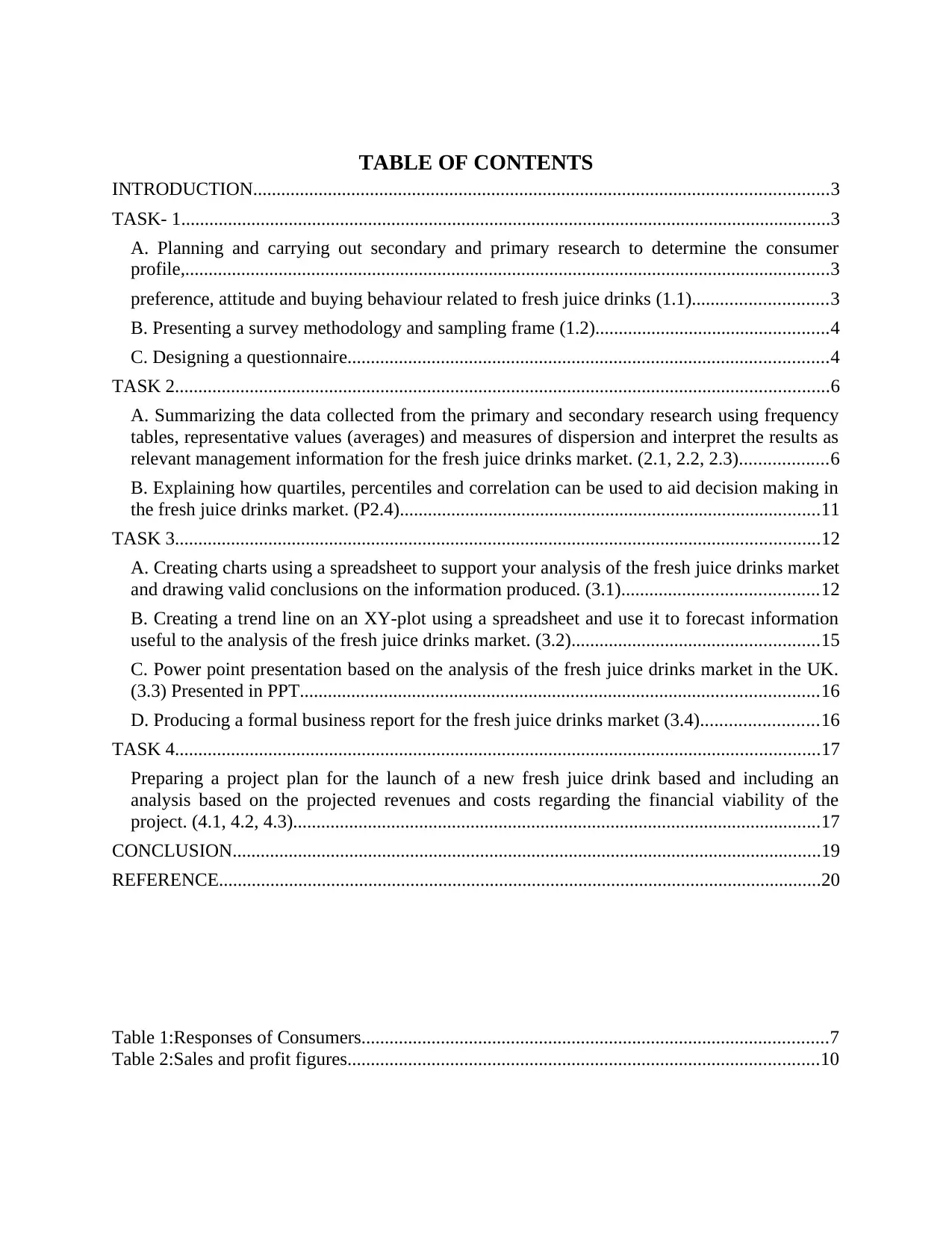
TABLE OF CONTENTS
INTRODUCTION...........................................................................................................................3
TASK- 1...........................................................................................................................................3
A. Planning and carrying out secondary and primary research to determine the consumer
profile,..........................................................................................................................................3
preference, attitude and buying behaviour related to fresh juice drinks (1.1).............................3
B. Presenting a survey methodology and sampling frame (1.2)..................................................4
C. Designing a questionnaire.......................................................................................................4
TASK 2............................................................................................................................................6
A. Summarizing the data collected from the primary and secondary research using frequency
tables, representative values (averages) and measures of dispersion and interpret the results as
relevant management information for the fresh juice drinks market. (2.1, 2.2, 2.3)...................6
B. Explaining how quartiles, percentiles and correlation can be used to aid decision making in
the fresh juice drinks market. (P2.4)..........................................................................................11
TASK 3..........................................................................................................................................12
A. Creating charts using a spreadsheet to support your analysis of the fresh juice drinks market
and drawing valid conclusions on the information produced. (3.1)..........................................12
B. Creating a trend line on an XY-plot using a spreadsheet and use it to forecast information
useful to the analysis of the fresh juice drinks market. (3.2).....................................................15
C. Power point presentation based on the analysis of the fresh juice drinks market in the UK.
(3.3) Presented in PPT...............................................................................................................16
D. Producing a formal business report for the fresh juice drinks market (3.4).........................16
TASK 4..........................................................................................................................................17
Preparing a project plan for the launch of a new fresh juice drink based and including an
analysis based on the projected revenues and costs regarding the financial viability of the
project. (4.1, 4.2, 4.3).................................................................................................................17
CONCLUSION..............................................................................................................................19
REFERENCE.................................................................................................................................20
Table 1:Responses of Consumers....................................................................................................7
Table 2:Sales and profit figures.....................................................................................................10
INTRODUCTION...........................................................................................................................3
TASK- 1...........................................................................................................................................3
A. Planning and carrying out secondary and primary research to determine the consumer
profile,..........................................................................................................................................3
preference, attitude and buying behaviour related to fresh juice drinks (1.1).............................3
B. Presenting a survey methodology and sampling frame (1.2)..................................................4
C. Designing a questionnaire.......................................................................................................4
TASK 2............................................................................................................................................6
A. Summarizing the data collected from the primary and secondary research using frequency
tables, representative values (averages) and measures of dispersion and interpret the results as
relevant management information for the fresh juice drinks market. (2.1, 2.2, 2.3)...................6
B. Explaining how quartiles, percentiles and correlation can be used to aid decision making in
the fresh juice drinks market. (P2.4)..........................................................................................11
TASK 3..........................................................................................................................................12
A. Creating charts using a spreadsheet to support your analysis of the fresh juice drinks market
and drawing valid conclusions on the information produced. (3.1)..........................................12
B. Creating a trend line on an XY-plot using a spreadsheet and use it to forecast information
useful to the analysis of the fresh juice drinks market. (3.2).....................................................15
C. Power point presentation based on the analysis of the fresh juice drinks market in the UK.
(3.3) Presented in PPT...............................................................................................................16
D. Producing a formal business report for the fresh juice drinks market (3.4).........................16
TASK 4..........................................................................................................................................17
Preparing a project plan for the launch of a new fresh juice drink based and including an
analysis based on the projected revenues and costs regarding the financial viability of the
project. (4.1, 4.2, 4.3).................................................................................................................17
CONCLUSION..............................................................................................................................19
REFERENCE.................................................................................................................................20
Table 1:Responses of Consumers....................................................................................................7
Table 2:Sales and profit figures.....................................................................................................10
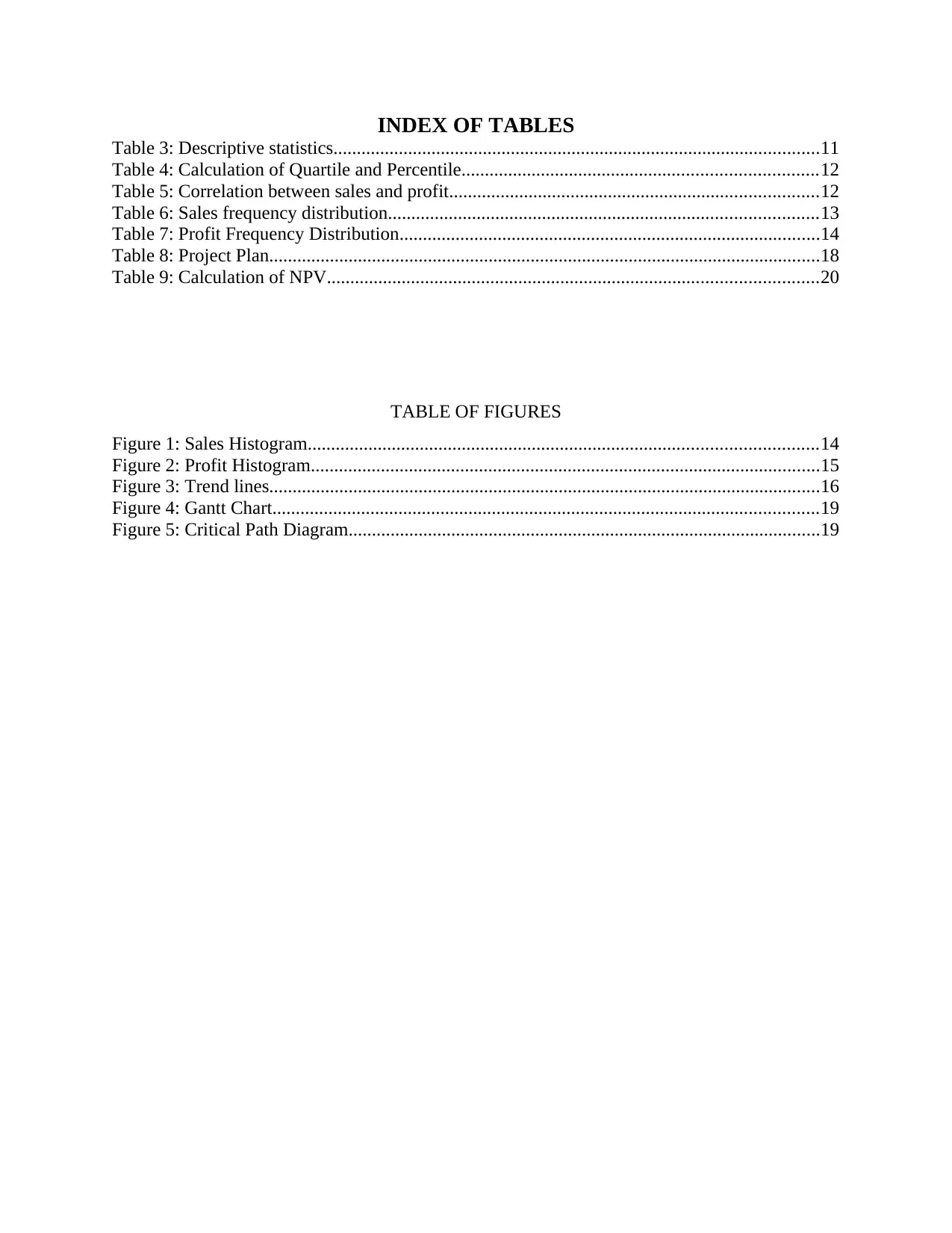
INDEX OF TABLES
Table 3: Descriptive statistics........................................................................................................11
Table 4: Calculation of Quartile and Percentile............................................................................12
Table 5: Correlation between sales and profit...............................................................................12
Table 6: Sales frequency distribution............................................................................................13
Table 7: Profit Frequency Distribution..........................................................................................14
Table 8: Project Plan......................................................................................................................18
Table 9: Calculation of NPV.........................................................................................................20
TABLE OF FIGURES
Figure 1: Sales Histogram.............................................................................................................14
Figure 2: Profit Histogram.............................................................................................................15
Figure 3: Trend lines......................................................................................................................16
Figure 4: Gantt Chart.....................................................................................................................19
Figure 5: Critical Path Diagram.....................................................................................................19
Table 3: Descriptive statistics........................................................................................................11
Table 4: Calculation of Quartile and Percentile............................................................................12
Table 5: Correlation between sales and profit...............................................................................12
Table 6: Sales frequency distribution............................................................................................13
Table 7: Profit Frequency Distribution..........................................................................................14
Table 8: Project Plan......................................................................................................................18
Table 9: Calculation of NPV.........................................................................................................20
TABLE OF FIGURES
Figure 1: Sales Histogram.............................................................................................................14
Figure 2: Profit Histogram.............................................................................................................15
Figure 3: Trend lines......................................................................................................................16
Figure 4: Gantt Chart.....................................................................................................................19
Figure 5: Critical Path Diagram.....................................................................................................19
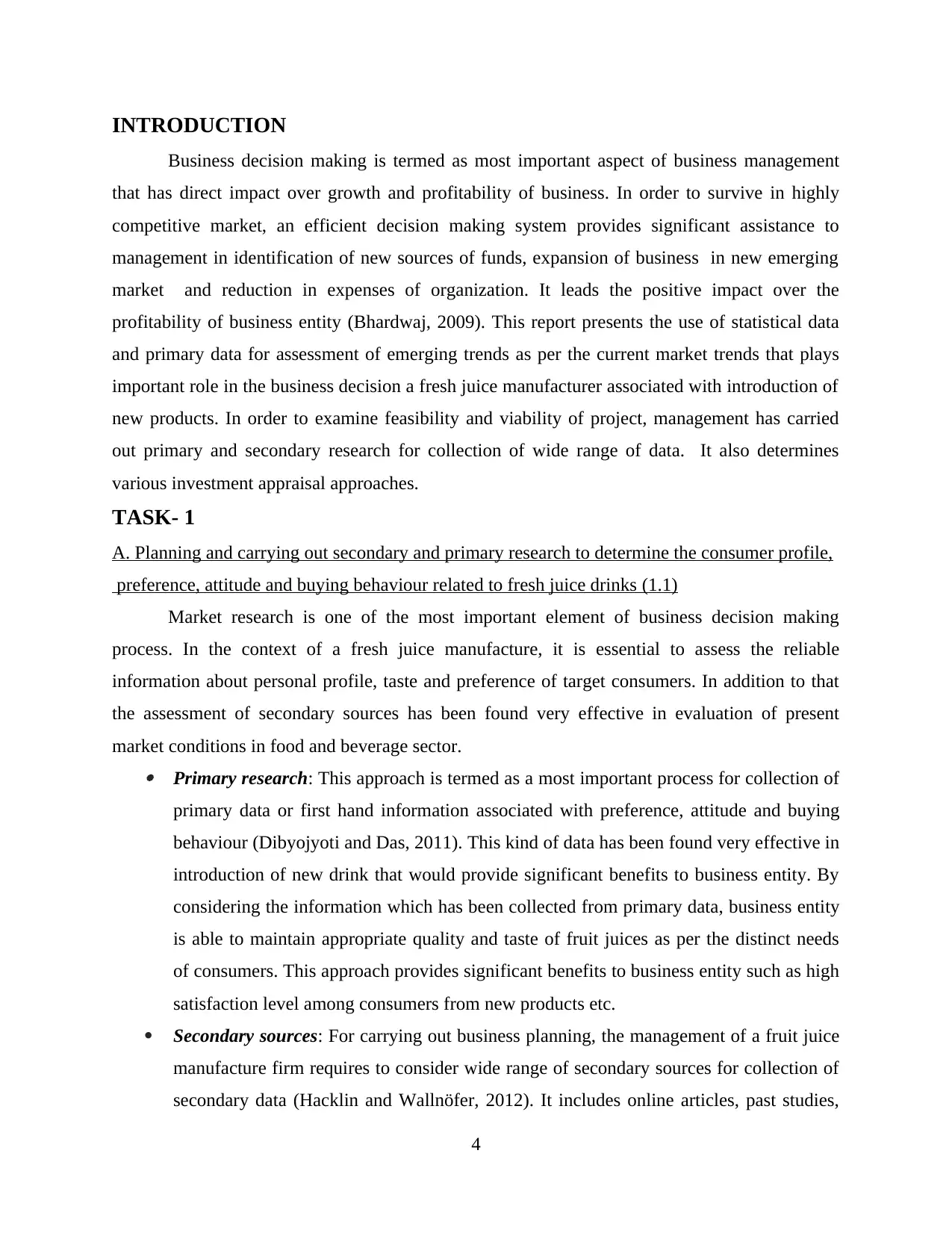
INTRODUCTION
Business decision making is termed as most important aspect of business management
that has direct impact over growth and profitability of business. In order to survive in highly
competitive market, an efficient decision making system provides significant assistance to
management in identification of new sources of funds, expansion of business in new emerging
market and reduction in expenses of organization. It leads the positive impact over the
profitability of business entity (Bhardwaj, 2009). This report presents the use of statistical data
and primary data for assessment of emerging trends as per the current market trends that plays
important role in the business decision a fresh juice manufacturer associated with introduction of
new products. In order to examine feasibility and viability of project, management has carried
out primary and secondary research for collection of wide range of data. It also determines
various investment appraisal approaches.
TASK- 1
A. Planning and carrying out secondary and primary research to determine the consumer profile,
preference, attitude and buying behaviour related to fresh juice drinks (1.1)
Market research is one of the most important element of business decision making
process. In the context of a fresh juice manufacture, it is essential to assess the reliable
information about personal profile, taste and preference of target consumers. In addition to that
the assessment of secondary sources has been found very effective in evaluation of present
market conditions in food and beverage sector. Primary research: This approach is termed as a most important process for collection of
primary data or first hand information associated with preference, attitude and buying
behaviour (Dibyojyoti and Das, 2011). This kind of data has been found very effective in
introduction of new drink that would provide significant benefits to business entity. By
considering the information which has been collected from primary data, business entity
is able to maintain appropriate quality and taste of fruit juices as per the distinct needs
of consumers. This approach provides significant benefits to business entity such as high
satisfaction level among consumers from new products etc.
Secondary sources: For carrying out business planning, the management of a fruit juice
manufacture firm requires to consider wide range of secondary sources for collection of
secondary data (Hacklin and Wallnöfer, 2012). It includes online articles, past studies,
4
Business decision making is termed as most important aspect of business management
that has direct impact over growth and profitability of business. In order to survive in highly
competitive market, an efficient decision making system provides significant assistance to
management in identification of new sources of funds, expansion of business in new emerging
market and reduction in expenses of organization. It leads the positive impact over the
profitability of business entity (Bhardwaj, 2009). This report presents the use of statistical data
and primary data for assessment of emerging trends as per the current market trends that plays
important role in the business decision a fresh juice manufacturer associated with introduction of
new products. In order to examine feasibility and viability of project, management has carried
out primary and secondary research for collection of wide range of data. It also determines
various investment appraisal approaches.
TASK- 1
A. Planning and carrying out secondary and primary research to determine the consumer profile,
preference, attitude and buying behaviour related to fresh juice drinks (1.1)
Market research is one of the most important element of business decision making
process. In the context of a fresh juice manufacture, it is essential to assess the reliable
information about personal profile, taste and preference of target consumers. In addition to that
the assessment of secondary sources has been found very effective in evaluation of present
market conditions in food and beverage sector. Primary research: This approach is termed as a most important process for collection of
primary data or first hand information associated with preference, attitude and buying
behaviour (Dibyojyoti and Das, 2011). This kind of data has been found very effective in
introduction of new drink that would provide significant benefits to business entity. By
considering the information which has been collected from primary data, business entity
is able to maintain appropriate quality and taste of fruit juices as per the distinct needs
of consumers. This approach provides significant benefits to business entity such as high
satisfaction level among consumers from new products etc.
Secondary sources: For carrying out business planning, the management of a fruit juice
manufacture firm requires to consider wide range of secondary sources for collection of
secondary data (Hacklin and Wallnöfer, 2012). It includes online articles, past studies,
4
Secure Best Marks with AI Grader
Need help grading? Try our AI Grader for instant feedback on your assignments.
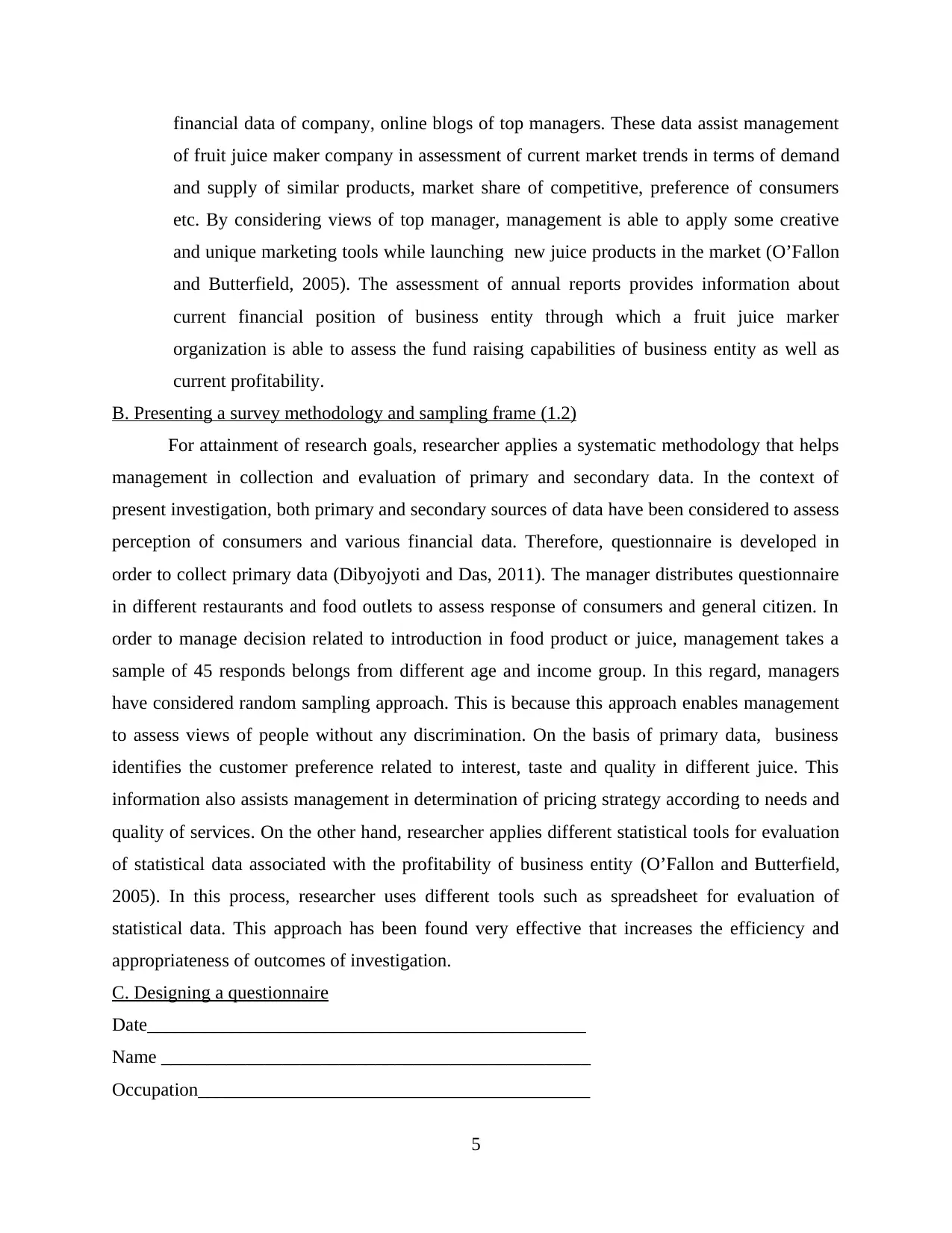
financial data of company, online blogs of top managers. These data assist management
of fruit juice maker company in assessment of current market trends in terms of demand
and supply of similar products, market share of competitive, preference of consumers
etc. By considering views of top manager, management is able to apply some creative
and unique marketing tools while launching new juice products in the market (O’Fallon
and Butterfield, 2005). The assessment of annual reports provides information about
current financial position of business entity through which a fruit juice marker
organization is able to assess the fund raising capabilities of business entity as well as
current profitability.
B. Presenting a survey methodology and sampling frame (1.2)
For attainment of research goals, researcher applies a systematic methodology that helps
management in collection and evaluation of primary and secondary data. In the context of
present investigation, both primary and secondary sources of data have been considered to assess
perception of consumers and various financial data. Therefore, questionnaire is developed in
order to collect primary data (Dibyojyoti and Das, 2011). The manager distributes questionnaire
in different restaurants and food outlets to assess response of consumers and general citizen. In
order to manage decision related to introduction in food product or juice, management takes a
sample of 45 responds belongs from different age and income group. In this regard, managers
have considered random sampling approach. This is because this approach enables management
to assess views of people without any discrimination. On the basis of primary data, business
identifies the customer preference related to interest, taste and quality in different juice. This
information also assists management in determination of pricing strategy according to needs and
quality of services. On the other hand, researcher applies different statistical tools for evaluation
of statistical data associated with the profitability of business entity (O’Fallon and Butterfield,
2005). In this process, researcher uses different tools such as spreadsheet for evaluation of
statistical data. This approach has been found very effective that increases the efficiency and
appropriateness of outcomes of investigation.
C. Designing a questionnaire
Date_______________________________________________
Name ______________________________________________
Occupation__________________________________________
5
of fruit juice maker company in assessment of current market trends in terms of demand
and supply of similar products, market share of competitive, preference of consumers
etc. By considering views of top manager, management is able to apply some creative
and unique marketing tools while launching new juice products in the market (O’Fallon
and Butterfield, 2005). The assessment of annual reports provides information about
current financial position of business entity through which a fruit juice marker
organization is able to assess the fund raising capabilities of business entity as well as
current profitability.
B. Presenting a survey methodology and sampling frame (1.2)
For attainment of research goals, researcher applies a systematic methodology that helps
management in collection and evaluation of primary and secondary data. In the context of
present investigation, both primary and secondary sources of data have been considered to assess
perception of consumers and various financial data. Therefore, questionnaire is developed in
order to collect primary data (Dibyojyoti and Das, 2011). The manager distributes questionnaire
in different restaurants and food outlets to assess response of consumers and general citizen. In
order to manage decision related to introduction in food product or juice, management takes a
sample of 45 responds belongs from different age and income group. In this regard, managers
have considered random sampling approach. This is because this approach enables management
to assess views of people without any discrimination. On the basis of primary data, business
identifies the customer preference related to interest, taste and quality in different juice. This
information also assists management in determination of pricing strategy according to needs and
quality of services. On the other hand, researcher applies different statistical tools for evaluation
of statistical data associated with the profitability of business entity (O’Fallon and Butterfield,
2005). In this process, researcher uses different tools such as spreadsheet for evaluation of
statistical data. This approach has been found very effective that increases the efficiency and
appropriateness of outcomes of investigation.
C. Designing a questionnaire
Date_______________________________________________
Name ______________________________________________
Occupation__________________________________________
5
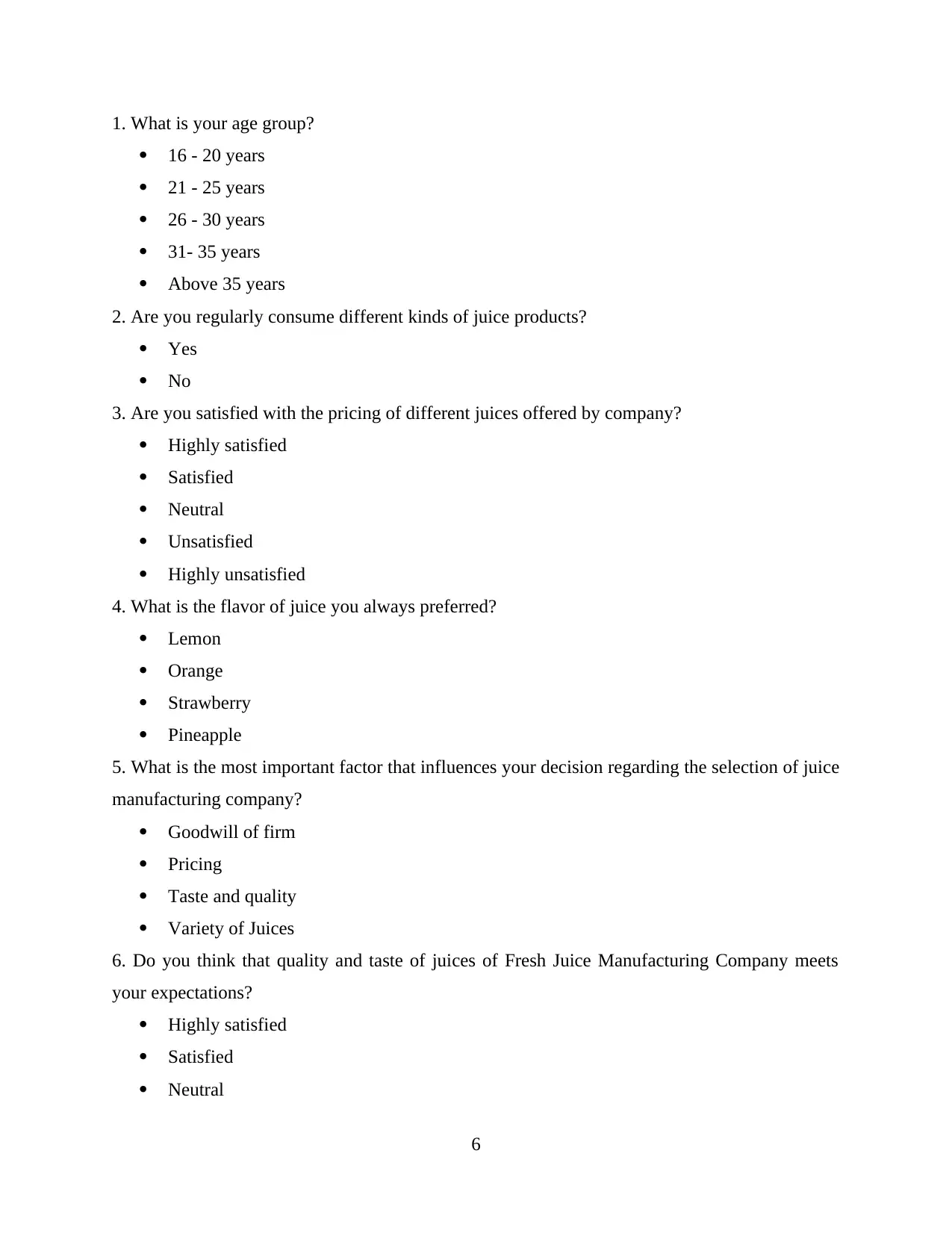
1. What is your age group?
16 - 20 years
21 - 25 years
26 - 30 years
31- 35 years
Above 35 years
2. Are you regularly consume different kinds of juice products?
Yes
No
3. Are you satisfied with the pricing of different juices offered by company?
Highly satisfied
Satisfied
Neutral
Unsatisfied
Highly unsatisfied
4. What is the flavor of juice you always preferred?
Lemon
Orange
Strawberry
Pineapple
5. What is the most important factor that influences your decision regarding the selection of juice
manufacturing company?
Goodwill of firm
Pricing
Taste and quality
Variety of Juices
6. Do you think that quality and taste of juices of Fresh Juice Manufacturing Company meets
your expectations?
Highly satisfied
Satisfied
Neutral
6
16 - 20 years
21 - 25 years
26 - 30 years
31- 35 years
Above 35 years
2. Are you regularly consume different kinds of juice products?
Yes
No
3. Are you satisfied with the pricing of different juices offered by company?
Highly satisfied
Satisfied
Neutral
Unsatisfied
Highly unsatisfied
4. What is the flavor of juice you always preferred?
Lemon
Orange
Strawberry
Pineapple
5. What is the most important factor that influences your decision regarding the selection of juice
manufacturing company?
Goodwill of firm
Pricing
Taste and quality
Variety of Juices
6. Do you think that quality and taste of juices of Fresh Juice Manufacturing Company meets
your expectations?
Highly satisfied
Satisfied
Neutral
6
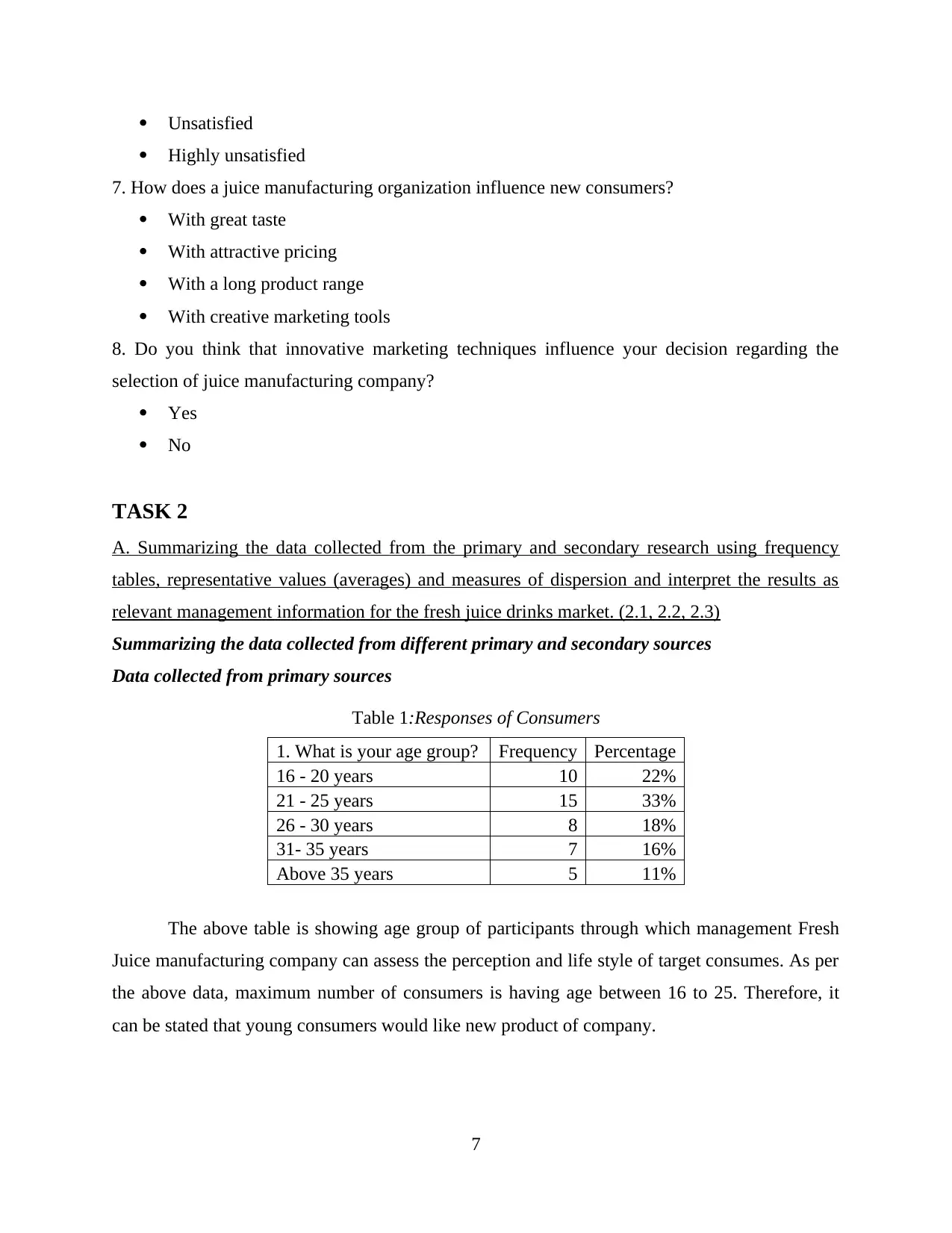
Unsatisfied
Highly unsatisfied
7. How does a juice manufacturing organization influence new consumers?
With great taste
With attractive pricing
With a long product range
With creative marketing tools
8. Do you think that innovative marketing techniques influence your decision regarding the
selection of juice manufacturing company?
Yes
No
TASK 2
A. Summarizing the data collected from the primary and secondary research using frequency
tables, representative values (averages) and measures of dispersion and interpret the results as
relevant management information for the fresh juice drinks market. (2.1, 2.2, 2.3)
Summarizing the data collected from different primary and secondary sources
Data collected from primary sources
Table 1:Responses of Consumers
1. What is your age group? Frequency Percentage
16 - 20 years 10 22%
21 - 25 years 15 33%
26 - 30 years 8 18%
31- 35 years 7 16%
Above 35 years 5 11%
The above table is showing age group of participants through which management Fresh
Juice manufacturing company can assess the perception and life style of target consumes. As per
the above data, maximum number of consumers is having age between 16 to 25. Therefore, it
can be stated that young consumers would like new product of company.
7
Highly unsatisfied
7. How does a juice manufacturing organization influence new consumers?
With great taste
With attractive pricing
With a long product range
With creative marketing tools
8. Do you think that innovative marketing techniques influence your decision regarding the
selection of juice manufacturing company?
Yes
No
TASK 2
A. Summarizing the data collected from the primary and secondary research using frequency
tables, representative values (averages) and measures of dispersion and interpret the results as
relevant management information for the fresh juice drinks market. (2.1, 2.2, 2.3)
Summarizing the data collected from different primary and secondary sources
Data collected from primary sources
Table 1:Responses of Consumers
1. What is your age group? Frequency Percentage
16 - 20 years 10 22%
21 - 25 years 15 33%
26 - 30 years 8 18%
31- 35 years 7 16%
Above 35 years 5 11%
The above table is showing age group of participants through which management Fresh
Juice manufacturing company can assess the perception and life style of target consumes. As per
the above data, maximum number of consumers is having age between 16 to 25. Therefore, it
can be stated that young consumers would like new product of company.
7
Paraphrase This Document
Need a fresh take? Get an instant paraphrase of this document with our AI Paraphraser
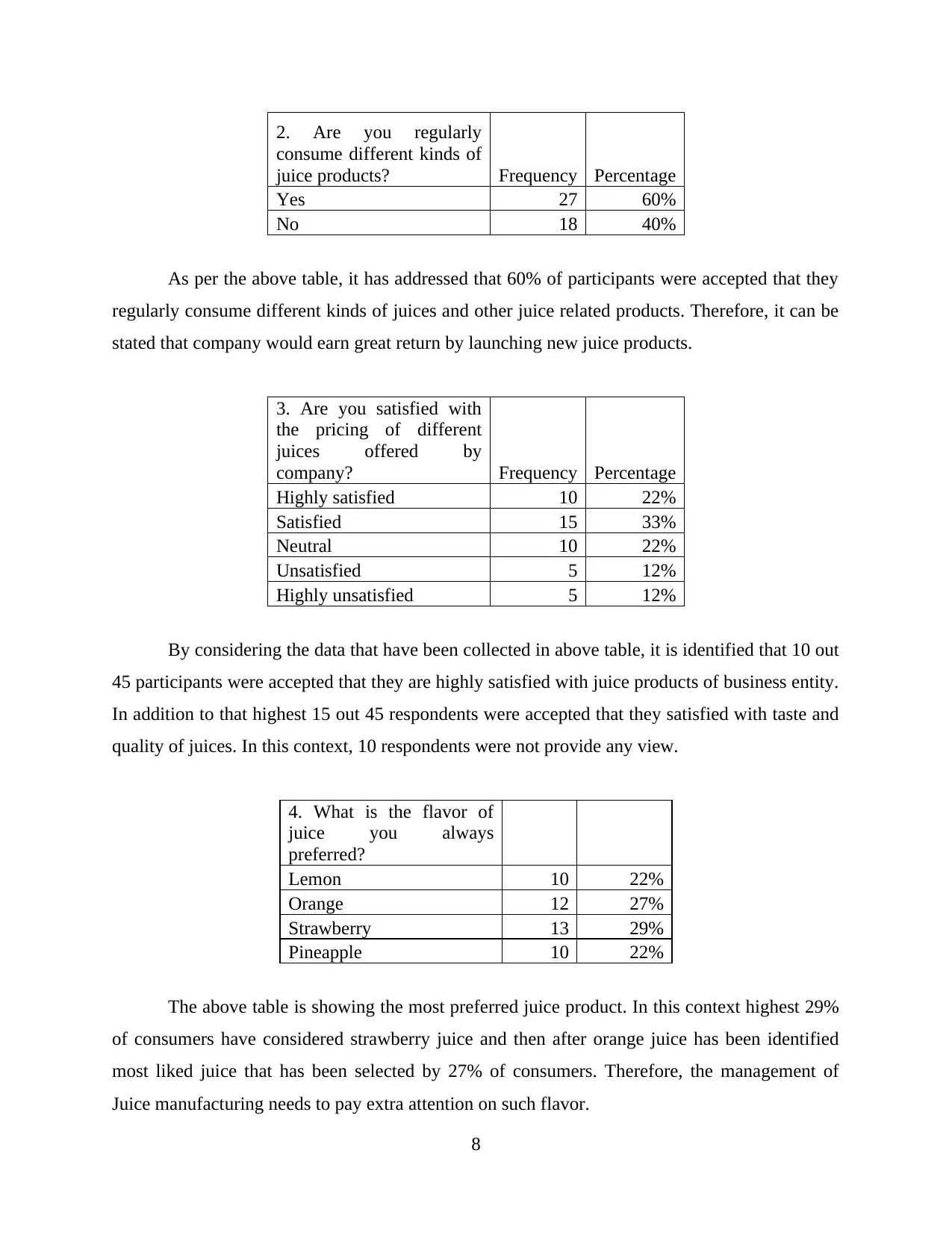
2. Are you regularly
consume different kinds of
juice products? Frequency Percentage
Yes 27 60%
No 18 40%
As per the above table, it has addressed that 60% of participants were accepted that they
regularly consume different kinds of juices and other juice related products. Therefore, it can be
stated that company would earn great return by launching new juice products.
3. Are you satisfied with
the pricing of different
juices offered by
company? Frequency Percentage
Highly satisfied 10 22%
Satisfied 15 33%
Neutral 10 22%
Unsatisfied 5 12%
Highly unsatisfied 5 12%
By considering the data that have been collected in above table, it is identified that 10 out
45 participants were accepted that they are highly satisfied with juice products of business entity.
In addition to that highest 15 out 45 respondents were accepted that they satisfied with taste and
quality of juices. In this context, 10 respondents were not provide any view.
4. What is the flavor of
juice you always
preferred?
Lemon 10 22%
Orange 12 27%
Strawberry 13 29%
Pineapple 10 22%
The above table is showing the most preferred juice product. In this context highest 29%
of consumers have considered strawberry juice and then after orange juice has been identified
most liked juice that has been selected by 27% of consumers. Therefore, the management of
Juice manufacturing needs to pay extra attention on such flavor.
8
consume different kinds of
juice products? Frequency Percentage
Yes 27 60%
No 18 40%
As per the above table, it has addressed that 60% of participants were accepted that they
regularly consume different kinds of juices and other juice related products. Therefore, it can be
stated that company would earn great return by launching new juice products.
3. Are you satisfied with
the pricing of different
juices offered by
company? Frequency Percentage
Highly satisfied 10 22%
Satisfied 15 33%
Neutral 10 22%
Unsatisfied 5 12%
Highly unsatisfied 5 12%
By considering the data that have been collected in above table, it is identified that 10 out
45 participants were accepted that they are highly satisfied with juice products of business entity.
In addition to that highest 15 out 45 respondents were accepted that they satisfied with taste and
quality of juices. In this context, 10 respondents were not provide any view.
4. What is the flavor of
juice you always
preferred?
Lemon 10 22%
Orange 12 27%
Strawberry 13 29%
Pineapple 10 22%
The above table is showing the most preferred juice product. In this context highest 29%
of consumers have considered strawberry juice and then after orange juice has been identified
most liked juice that has been selected by 27% of consumers. Therefore, the management of
Juice manufacturing needs to pay extra attention on such flavor.
8
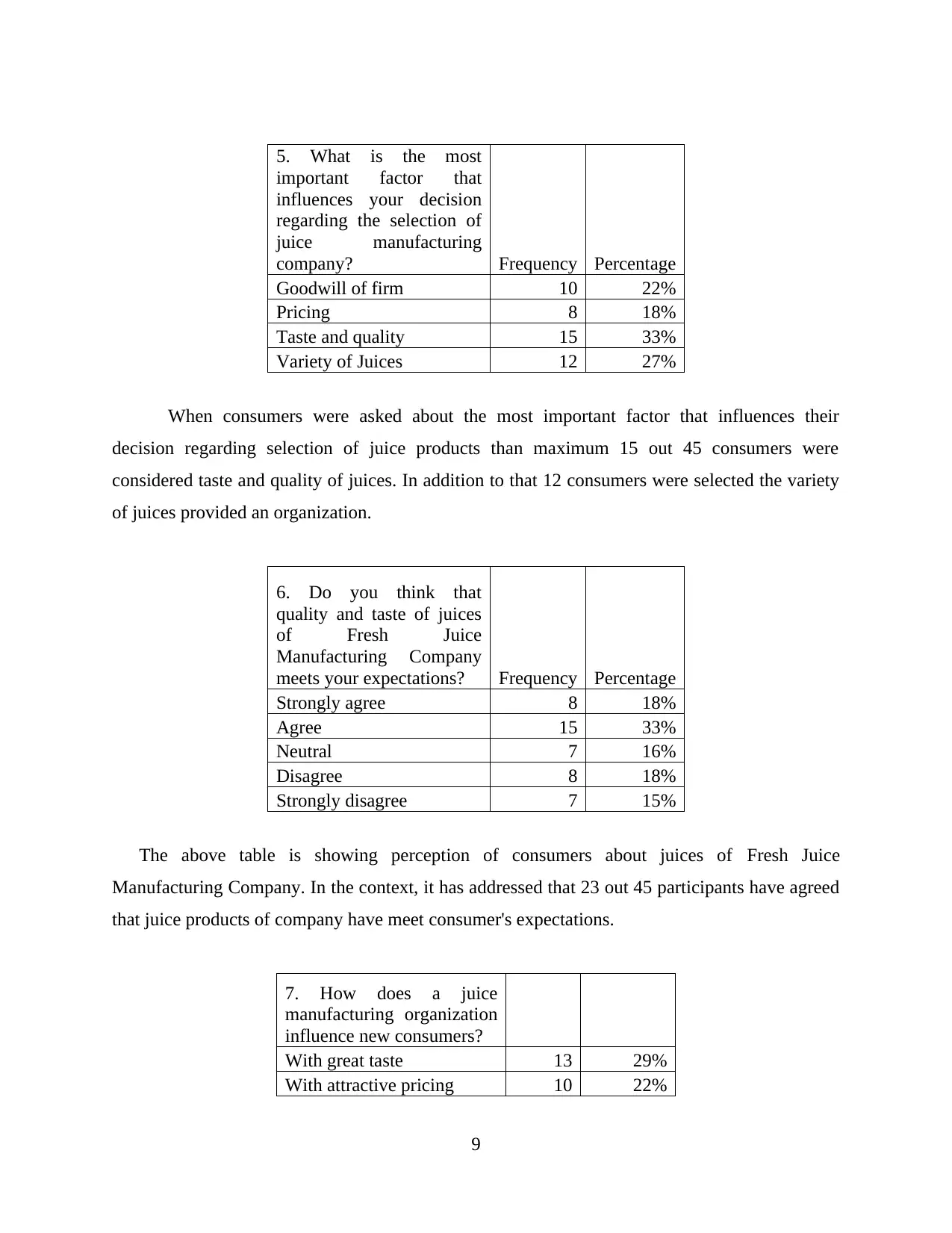
5. What is the most
important factor that
influences your decision
regarding the selection of
juice manufacturing
company? Frequency Percentage
Goodwill of firm 10 22%
Pricing 8 18%
Taste and quality 15 33%
Variety of Juices 12 27%
When consumers were asked about the most important factor that influences their
decision regarding selection of juice products than maximum 15 out 45 consumers were
considered taste and quality of juices. In addition to that 12 consumers were selected the variety
of juices provided an organization.
6. Do you think that
quality and taste of juices
of Fresh Juice
Manufacturing Company
meets your expectations? Frequency Percentage
Strongly agree 8 18%
Agree 15 33%
Neutral 7 16%
Disagree 8 18%
Strongly disagree 7 15%
The above table is showing perception of consumers about juices of Fresh Juice
Manufacturing Company. In the context, it has addressed that 23 out 45 participants have agreed
that juice products of company have meet consumer's expectations.
7. How does a juice
manufacturing organization
influence new consumers?
With great taste 13 29%
With attractive pricing 10 22%
9
important factor that
influences your decision
regarding the selection of
juice manufacturing
company? Frequency Percentage
Goodwill of firm 10 22%
Pricing 8 18%
Taste and quality 15 33%
Variety of Juices 12 27%
When consumers were asked about the most important factor that influences their
decision regarding selection of juice products than maximum 15 out 45 consumers were
considered taste and quality of juices. In addition to that 12 consumers were selected the variety
of juices provided an organization.
6. Do you think that
quality and taste of juices
of Fresh Juice
Manufacturing Company
meets your expectations? Frequency Percentage
Strongly agree 8 18%
Agree 15 33%
Neutral 7 16%
Disagree 8 18%
Strongly disagree 7 15%
The above table is showing perception of consumers about juices of Fresh Juice
Manufacturing Company. In the context, it has addressed that 23 out 45 participants have agreed
that juice products of company have meet consumer's expectations.
7. How does a juice
manufacturing organization
influence new consumers?
With great taste 13 29%
With attractive pricing 10 22%
9
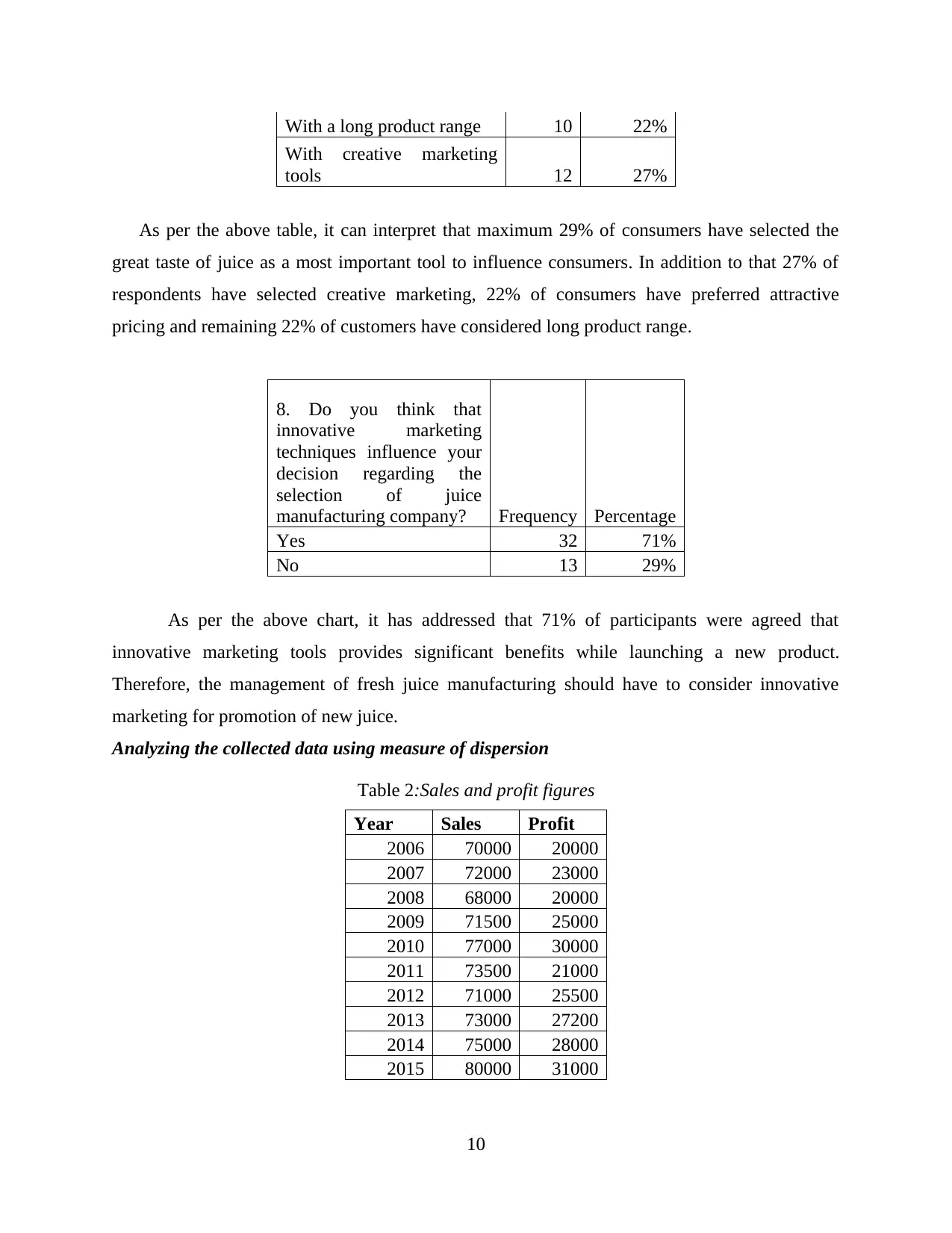
With a long product range 10 22%
With creative marketing
tools 12 27%
As per the above table, it can interpret that maximum 29% of consumers have selected the
great taste of juice as a most important tool to influence consumers. In addition to that 27% of
respondents have selected creative marketing, 22% of consumers have preferred attractive
pricing and remaining 22% of customers have considered long product range.
8. Do you think that
innovative marketing
techniques influence your
decision regarding the
selection of juice
manufacturing company? Frequency Percentage
Yes 32 71%
No 13 29%
As per the above chart, it has addressed that 71% of participants were agreed that
innovative marketing tools provides significant benefits while launching a new product.
Therefore, the management of fresh juice manufacturing should have to consider innovative
marketing for promotion of new juice.
Analyzing the collected data using measure of dispersion
Table 2:Sales and profit figures
Year Sales Profit
2006 70000 20000
2007 72000 23000
2008 68000 20000
2009 71500 25000
2010 77000 30000
2011 73500 21000
2012 71000 25500
2013 73000 27200
2014 75000 28000
2015 80000 31000
10
With creative marketing
tools 12 27%
As per the above table, it can interpret that maximum 29% of consumers have selected the
great taste of juice as a most important tool to influence consumers. In addition to that 27% of
respondents have selected creative marketing, 22% of consumers have preferred attractive
pricing and remaining 22% of customers have considered long product range.
8. Do you think that
innovative marketing
techniques influence your
decision regarding the
selection of juice
manufacturing company? Frequency Percentage
Yes 32 71%
No 13 29%
As per the above chart, it has addressed that 71% of participants were agreed that
innovative marketing tools provides significant benefits while launching a new product.
Therefore, the management of fresh juice manufacturing should have to consider innovative
marketing for promotion of new juice.
Analyzing the collected data using measure of dispersion
Table 2:Sales and profit figures
Year Sales Profit
2006 70000 20000
2007 72000 23000
2008 68000 20000
2009 71500 25000
2010 77000 30000
2011 73500 21000
2012 71000 25500
2013 73000 27200
2014 75000 28000
2015 80000 31000
10
Secure Best Marks with AI Grader
Need help grading? Try our AI Grader for instant feedback on your assignments.
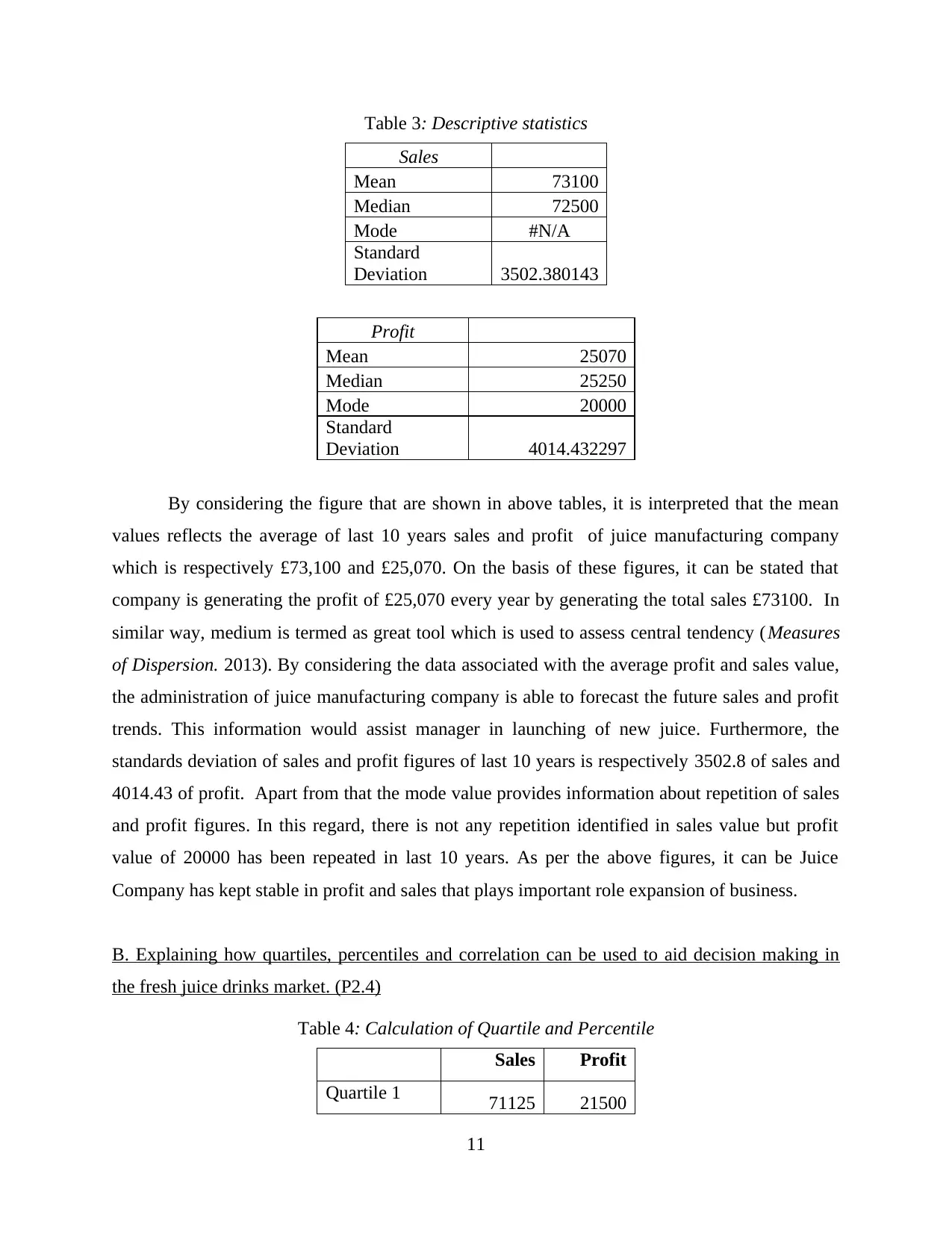
Table 3: Descriptive statistics
Sales
Mean 73100
Median 72500
Mode #N/A
Standard
Deviation 3502.380143
Profit
Mean 25070
Median 25250
Mode 20000
Standard
Deviation 4014.432297
By considering the figure that are shown in above tables, it is interpreted that the mean
values reflects the average of last 10 years sales and profit of juice manufacturing company
which is respectively £73,100 and £25,070. On the basis of these figures, it can be stated that
company is generating the profit of £25,070 every year by generating the total sales £73100. In
similar way, medium is termed as great tool which is used to assess central tendency (Measures
of Dispersion. 2013). By considering the data associated with the average profit and sales value,
the administration of juice manufacturing company is able to forecast the future sales and profit
trends. This information would assist manager in launching of new juice. Furthermore, the
standards deviation of sales and profit figures of last 10 years is respectively 3502.8 of sales and
4014.43 of profit. Apart from that the mode value provides information about repetition of sales
and profit figures. In this regard, there is not any repetition identified in sales value but profit
value of 20000 has been repeated in last 10 years. As per the above figures, it can be Juice
Company has kept stable in profit and sales that plays important role expansion of business.
B. Explaining how quartiles, percentiles and correlation can be used to aid decision making in
the fresh juice drinks market. (P2.4)
Table 4: Calculation of Quartile and Percentile
Sales Profit
Quartile 1 71125 21500
11
Sales
Mean 73100
Median 72500
Mode #N/A
Standard
Deviation 3502.380143
Profit
Mean 25070
Median 25250
Mode 20000
Standard
Deviation 4014.432297
By considering the figure that are shown in above tables, it is interpreted that the mean
values reflects the average of last 10 years sales and profit of juice manufacturing company
which is respectively £73,100 and £25,070. On the basis of these figures, it can be stated that
company is generating the profit of £25,070 every year by generating the total sales £73100. In
similar way, medium is termed as great tool which is used to assess central tendency (Measures
of Dispersion. 2013). By considering the data associated with the average profit and sales value,
the administration of juice manufacturing company is able to forecast the future sales and profit
trends. This information would assist manager in launching of new juice. Furthermore, the
standards deviation of sales and profit figures of last 10 years is respectively 3502.8 of sales and
4014.43 of profit. Apart from that the mode value provides information about repetition of sales
and profit figures. In this regard, there is not any repetition identified in sales value but profit
value of 20000 has been repeated in last 10 years. As per the above figures, it can be Juice
Company has kept stable in profit and sales that plays important role expansion of business.
B. Explaining how quartiles, percentiles and correlation can be used to aid decision making in
the fresh juice drinks market. (P2.4)
Table 4: Calculation of Quartile and Percentile
Sales Profit
Quartile 1 71125 21500
11
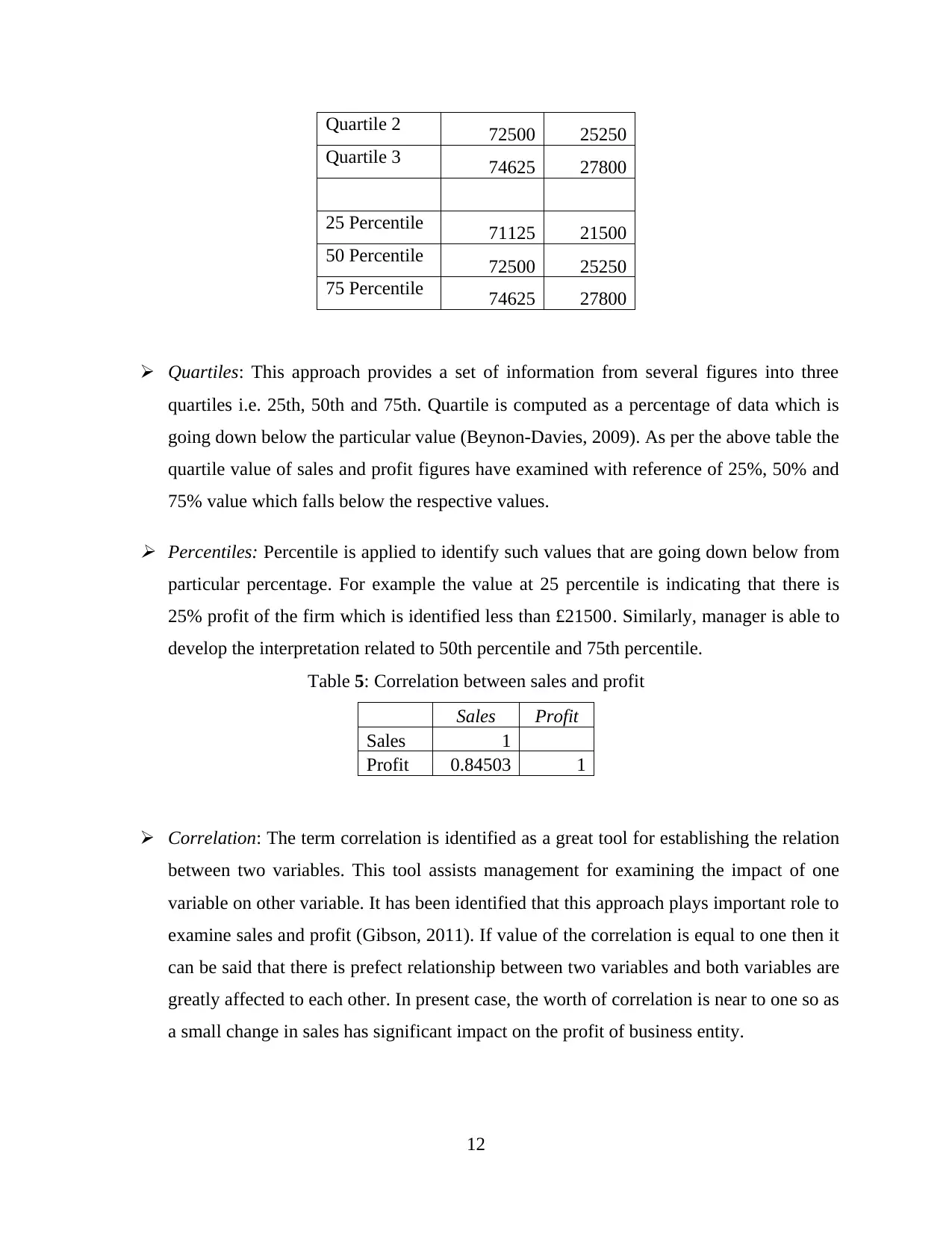
Quartile 2 72500 25250
Quartile 3 74625 27800
25 Percentile 71125 21500
50 Percentile 72500 25250
75 Percentile 74625 27800
Quartiles: This approach provides a set of information from several figures into three
quartiles i.e. 25th, 50th and 75th. Quartile is computed as a percentage of data which is
going down below the particular value (Beynon-Davies, 2009). As per the above table the
quartile value of sales and profit figures have examined with reference of 25%, 50% and
75% value which falls below the respective values.
Percentiles: Percentile is applied to identify such values that are going down below from
particular percentage. For example the value at 25 percentile is indicating that there is
25% profit of the firm which is identified less than £21500. Similarly, manager is able to
develop the interpretation related to 50th percentile and 75th percentile.
Table 5: Correlation between sales and profit
Sales Profit
Sales 1
Profit 0.84503 1
Correlation: The term correlation is identified as a great tool for establishing the relation
between two variables. This tool assists management for examining the impact of one
variable on other variable. It has been identified that this approach plays important role to
examine sales and profit (Gibson, 2011). If value of the correlation is equal to one then it
can be said that there is prefect relationship between two variables and both variables are
greatly affected to each other. In present case, the worth of correlation is near to one so as
a small change in sales has significant impact on the profit of business entity.
12
Quartile 3 74625 27800
25 Percentile 71125 21500
50 Percentile 72500 25250
75 Percentile 74625 27800
Quartiles: This approach provides a set of information from several figures into three
quartiles i.e. 25th, 50th and 75th. Quartile is computed as a percentage of data which is
going down below the particular value (Beynon-Davies, 2009). As per the above table the
quartile value of sales and profit figures have examined with reference of 25%, 50% and
75% value which falls below the respective values.
Percentiles: Percentile is applied to identify such values that are going down below from
particular percentage. For example the value at 25 percentile is indicating that there is
25% profit of the firm which is identified less than £21500. Similarly, manager is able to
develop the interpretation related to 50th percentile and 75th percentile.
Table 5: Correlation between sales and profit
Sales Profit
Sales 1
Profit 0.84503 1
Correlation: The term correlation is identified as a great tool for establishing the relation
between two variables. This tool assists management for examining the impact of one
variable on other variable. It has been identified that this approach plays important role to
examine sales and profit (Gibson, 2011). If value of the correlation is equal to one then it
can be said that there is prefect relationship between two variables and both variables are
greatly affected to each other. In present case, the worth of correlation is near to one so as
a small change in sales has significant impact on the profit of business entity.
12
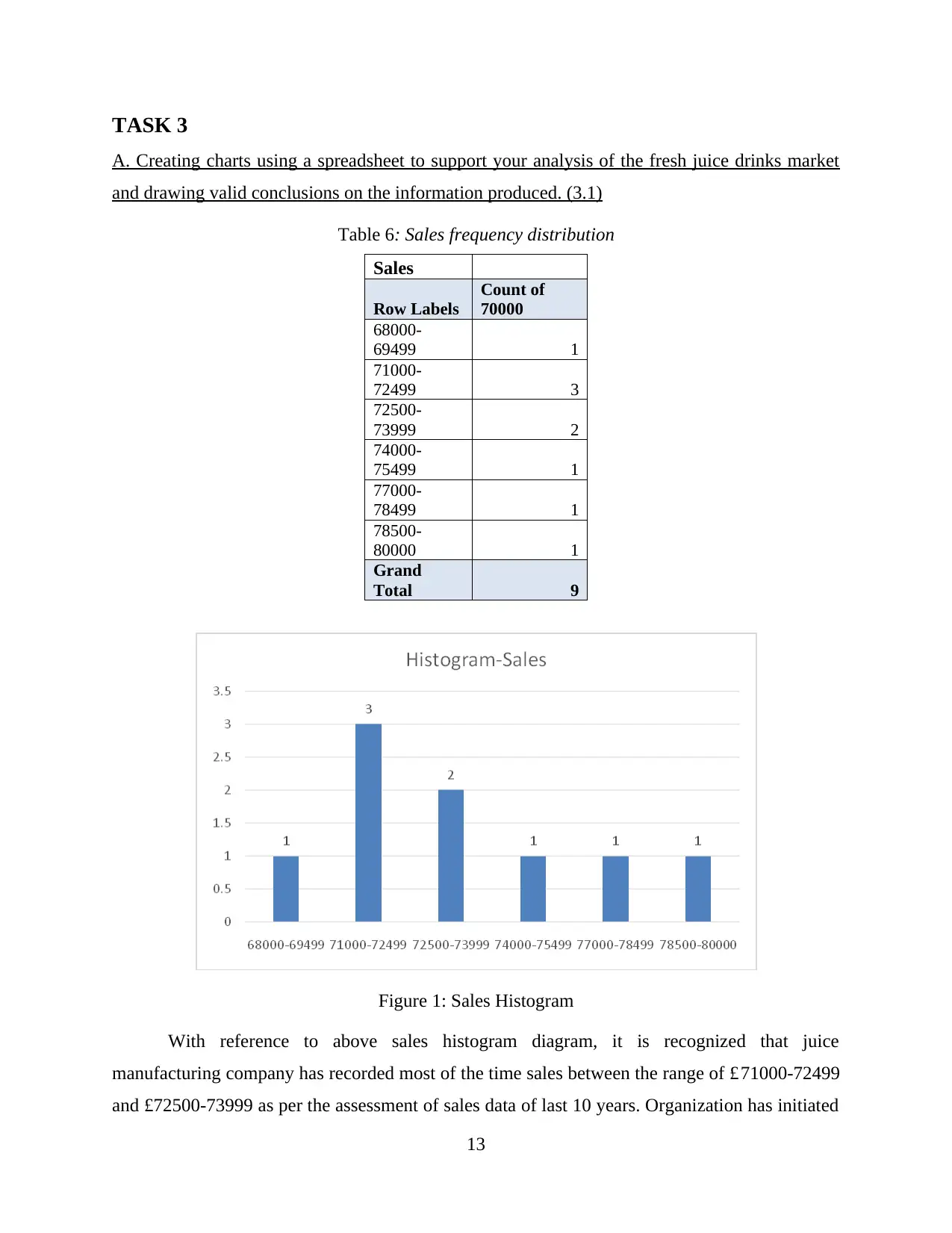
TASK 3
A. Creating charts using a spreadsheet to support your analysis of the fresh juice drinks market
and drawing valid conclusions on the information produced. (3.1)
Table 6: Sales frequency distribution
Sales
Row Labels
Count of
70000
68000-
69499 1
71000-
72499 3
72500-
73999 2
74000-
75499 1
77000-
78499 1
78500-
80000 1
Grand
Total 9
Figure 1: Sales Histogram
With reference to above sales histogram diagram, it is recognized that juice
manufacturing company has recorded most of the time sales between the range of £71000-72499
and £72500-73999 as per the assessment of sales data of last 10 years. Organization has initiated
13
A. Creating charts using a spreadsheet to support your analysis of the fresh juice drinks market
and drawing valid conclusions on the information produced. (3.1)
Table 6: Sales frequency distribution
Sales
Row Labels
Count of
70000
68000-
69499 1
71000-
72499 3
72500-
73999 2
74000-
75499 1
77000-
78499 1
78500-
80000 1
Grand
Total 9
Figure 1: Sales Histogram
With reference to above sales histogram diagram, it is recognized that juice
manufacturing company has recorded most of the time sales between the range of £71000-72499
and £72500-73999 as per the assessment of sales data of last 10 years. Organization has initiated
13
Paraphrase This Document
Need a fresh take? Get an instant paraphrase of this document with our AI Paraphraser
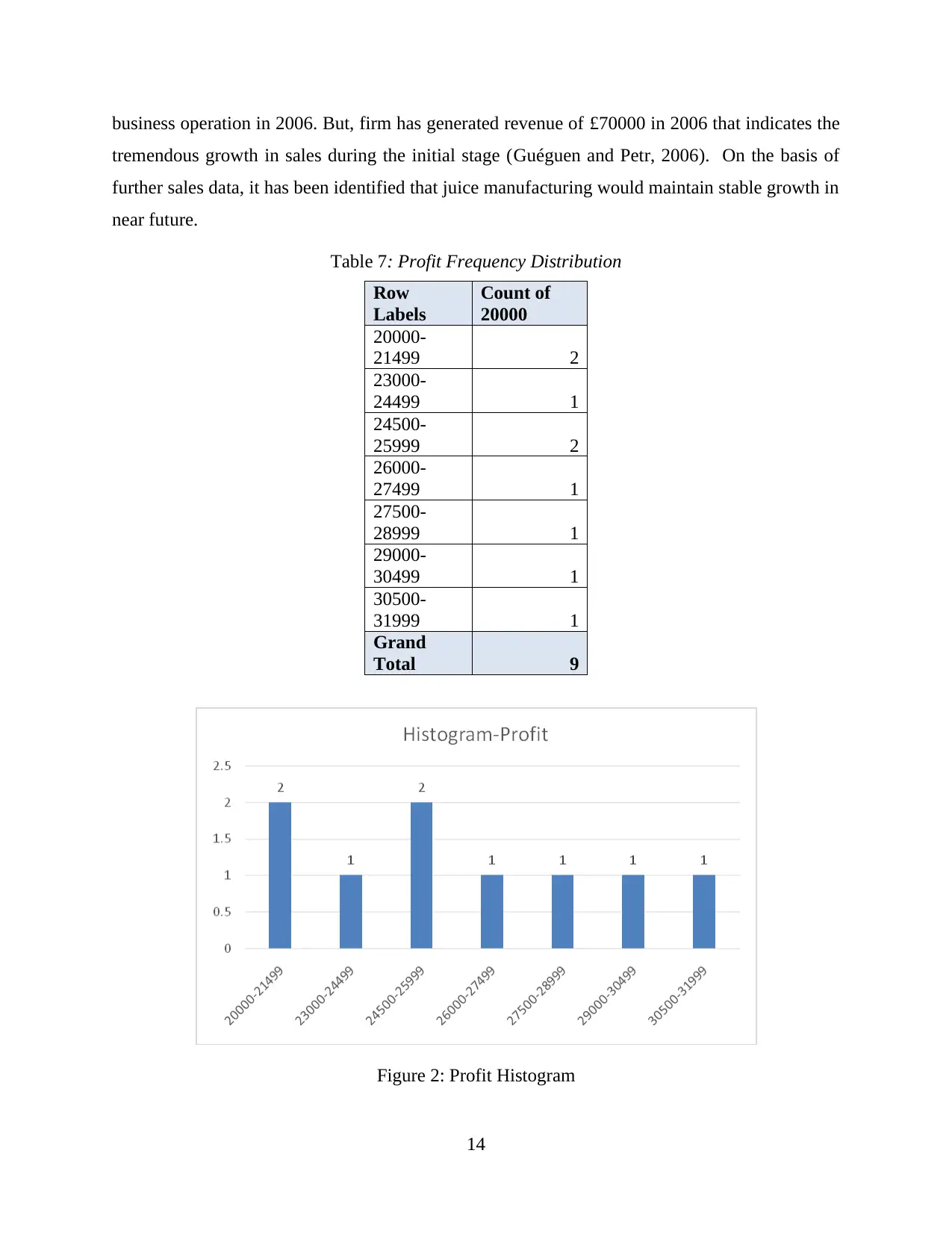
business operation in 2006. But, firm has generated revenue of £70000 in 2006 that indicates the
tremendous growth in sales during the initial stage (Guéguen and Petr, 2006). On the basis of
further sales data, it has been identified that juice manufacturing would maintain stable growth in
near future.
Table 7: Profit Frequency Distribution
Row
Labels
Count of
20000
20000-
21499 2
23000-
24499 1
24500-
25999 2
26000-
27499 1
27500-
28999 1
29000-
30499 1
30500-
31999 1
Grand
Total 9
Figure 2: Profit Histogram
14
tremendous growth in sales during the initial stage (Guéguen and Petr, 2006). On the basis of
further sales data, it has been identified that juice manufacturing would maintain stable growth in
near future.
Table 7: Profit Frequency Distribution
Row
Labels
Count of
20000
20000-
21499 2
23000-
24499 1
24500-
25999 2
26000-
27499 1
27500-
28999 1
29000-
30499 1
30500-
31999 1
Grand
Total 9
Figure 2: Profit Histogram
14
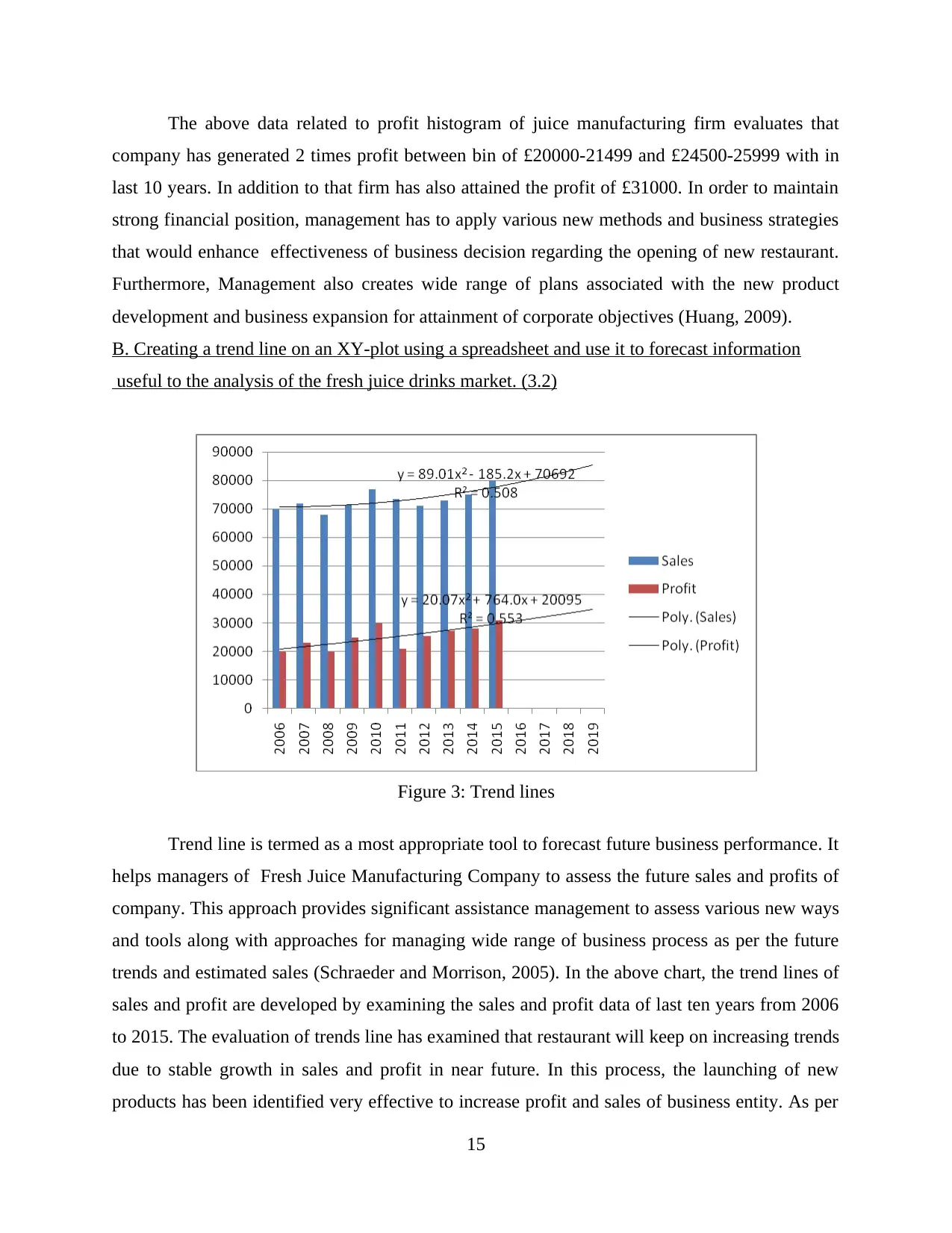
The above data related to profit histogram of juice manufacturing firm evaluates that
company has generated 2 times profit between bin of £20000-21499 and £24500-25999 with in
last 10 years. In addition to that firm has also attained the profit of £31000. In order to maintain
strong financial position, management has to apply various new methods and business strategies
that would enhance effectiveness of business decision regarding the opening of new restaurant.
Furthermore, Management also creates wide range of plans associated with the new product
development and business expansion for attainment of corporate objectives (Huang, 2009).
B. Creating a trend line on an XY-plot using a spreadsheet and use it to forecast information
useful to the analysis of the fresh juice drinks market. (3.2)
Figure 3: Trend lines
Trend line is termed as a most appropriate tool to forecast future business performance. It
helps managers of Fresh Juice Manufacturing Company to assess the future sales and profits of
company. This approach provides significant assistance management to assess various new ways
and tools along with approaches for managing wide range of business process as per the future
trends and estimated sales (Schraeder and Morrison, 2005). In the above chart, the trend lines of
sales and profit are developed by examining the sales and profit data of last ten years from 2006
to 2015. The evaluation of trends line has examined that restaurant will keep on increasing trends
due to stable growth in sales and profit in near future. In this process, the launching of new
products has been identified very effective to increase profit and sales of business entity. As per
15
company has generated 2 times profit between bin of £20000-21499 and £24500-25999 with in
last 10 years. In addition to that firm has also attained the profit of £31000. In order to maintain
strong financial position, management has to apply various new methods and business strategies
that would enhance effectiveness of business decision regarding the opening of new restaurant.
Furthermore, Management also creates wide range of plans associated with the new product
development and business expansion for attainment of corporate objectives (Huang, 2009).
B. Creating a trend line on an XY-plot using a spreadsheet and use it to forecast information
useful to the analysis of the fresh juice drinks market. (3.2)
Figure 3: Trend lines
Trend line is termed as a most appropriate tool to forecast future business performance. It
helps managers of Fresh Juice Manufacturing Company to assess the future sales and profits of
company. This approach provides significant assistance management to assess various new ways
and tools along with approaches for managing wide range of business process as per the future
trends and estimated sales (Schraeder and Morrison, 2005). In the above chart, the trend lines of
sales and profit are developed by examining the sales and profit data of last ten years from 2006
to 2015. The evaluation of trends line has examined that restaurant will keep on increasing trends
due to stable growth in sales and profit in near future. In this process, the launching of new
products has been identified very effective to increase profit and sales of business entity. As per
15
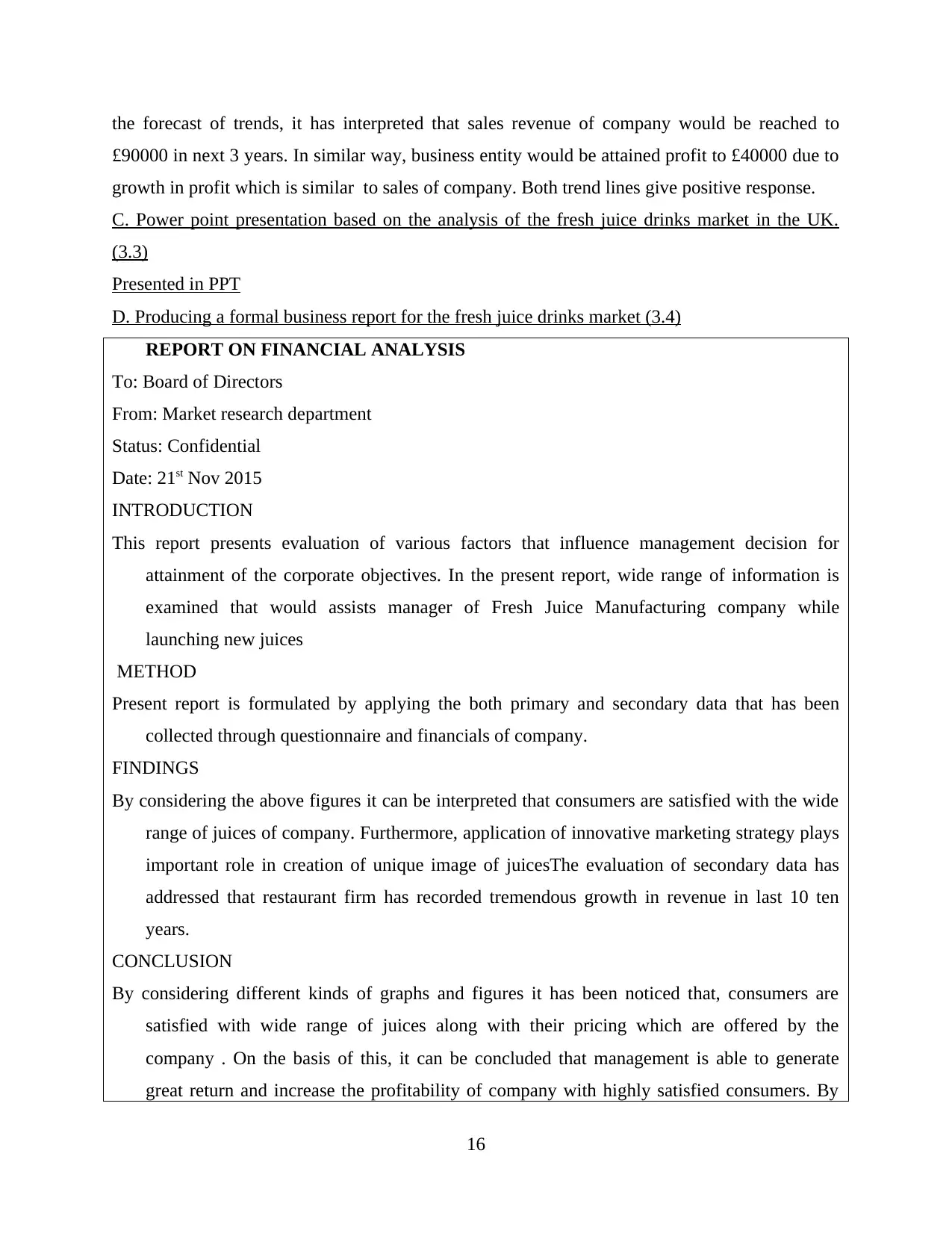
the forecast of trends, it has interpreted that sales revenue of company would be reached to
£90000 in next 3 years. In similar way, business entity would be attained profit to £40000 due to
growth in profit which is similar to sales of company. Both trend lines give positive response.
C. Power point presentation based on the analysis of the fresh juice drinks market in the UK.
(3.3)
Presented in PPT
D. Producing a formal business report for the fresh juice drinks market (3.4)
REPORT ON FINANCIAL ANALYSIS
To: Board of Directors
From: Market research department
Status: Confidential
Date: 21st Nov 2015
INTRODUCTION
This report presents evaluation of various factors that influence management decision for
attainment of the corporate objectives. In the present report, wide range of information is
examined that would assists manager of Fresh Juice Manufacturing company while
launching new juices
METHOD
Present report is formulated by applying the both primary and secondary data that has been
collected through questionnaire and financials of company.
FINDINGS
By considering the above figures it can be interpreted that consumers are satisfied with the wide
range of juices of company. Furthermore, application of innovative marketing strategy plays
important role in creation of unique image of juicesThe evaluation of secondary data has
addressed that restaurant firm has recorded tremendous growth in revenue in last 10 ten
years.
CONCLUSION
By considering different kinds of graphs and figures it has been noticed that, consumers are
satisfied with wide range of juices along with their pricing which are offered by the
company . On the basis of this, it can be concluded that management is able to generate
great return and increase the profitability of company with highly satisfied consumers. By
16
£90000 in next 3 years. In similar way, business entity would be attained profit to £40000 due to
growth in profit which is similar to sales of company. Both trend lines give positive response.
C. Power point presentation based on the analysis of the fresh juice drinks market in the UK.
(3.3)
Presented in PPT
D. Producing a formal business report for the fresh juice drinks market (3.4)
REPORT ON FINANCIAL ANALYSIS
To: Board of Directors
From: Market research department
Status: Confidential
Date: 21st Nov 2015
INTRODUCTION
This report presents evaluation of various factors that influence management decision for
attainment of the corporate objectives. In the present report, wide range of information is
examined that would assists manager of Fresh Juice Manufacturing company while
launching new juices
METHOD
Present report is formulated by applying the both primary and secondary data that has been
collected through questionnaire and financials of company.
FINDINGS
By considering the above figures it can be interpreted that consumers are satisfied with the wide
range of juices of company. Furthermore, application of innovative marketing strategy plays
important role in creation of unique image of juicesThe evaluation of secondary data has
addressed that restaurant firm has recorded tremendous growth in revenue in last 10 ten
years.
CONCLUSION
By considering different kinds of graphs and figures it has been noticed that, consumers are
satisfied with wide range of juices along with their pricing which are offered by the
company . On the basis of this, it can be concluded that management is able to generate
great return and increase the profitability of company with highly satisfied consumers. By
16
Secure Best Marks with AI Grader
Need help grading? Try our AI Grader for instant feedback on your assignments.
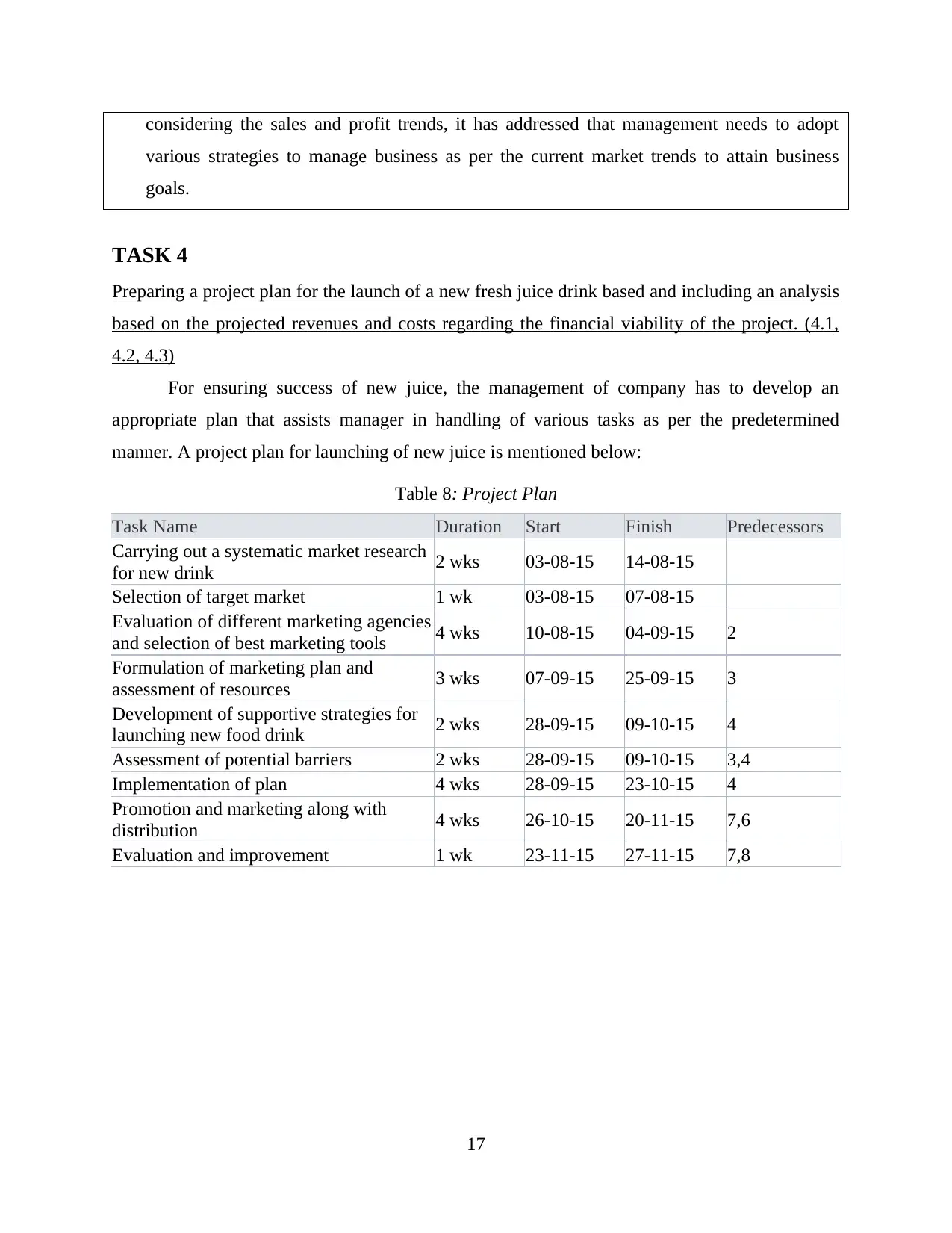
considering the sales and profit trends, it has addressed that management needs to adopt
various strategies to manage business as per the current market trends to attain business
goals.
TASK 4
Preparing a project plan for the launch of a new fresh juice drink based and including an analysis
based on the projected revenues and costs regarding the financial viability of the project. (4.1,
4.2, 4.3)
For ensuring success of new juice, the management of company has to develop an
appropriate plan that assists manager in handling of various tasks as per the predetermined
manner. A project plan for launching of new juice is mentioned below:
Table 8: Project Plan
Task Name Duration Start Finish Predecessors
Carrying out a systematic market research
for new drink 2 wks 03-08-15 14-08-15
Selection of target market 1 wk 03-08-15 07-08-15
Evaluation of different marketing agencies
and selection of best marketing tools 4 wks 10-08-15 04-09-15 2
Formulation of marketing plan and
assessment of resources 3 wks 07-09-15 25-09-15 3
Development of supportive strategies for
launching new food drink 2 wks 28-09-15 09-10-15 4
Assessment of potential barriers 2 wks 28-09-15 09-10-15 3,4
Implementation of plan 4 wks 28-09-15 23-10-15 4
Promotion and marketing along with
distribution 4 wks 26-10-15 20-11-15 7,6
Evaluation and improvement 1 wk 23-11-15 27-11-15 7,8
17
various strategies to manage business as per the current market trends to attain business
goals.
TASK 4
Preparing a project plan for the launch of a new fresh juice drink based and including an analysis
based on the projected revenues and costs regarding the financial viability of the project. (4.1,
4.2, 4.3)
For ensuring success of new juice, the management of company has to develop an
appropriate plan that assists manager in handling of various tasks as per the predetermined
manner. A project plan for launching of new juice is mentioned below:
Table 8: Project Plan
Task Name Duration Start Finish Predecessors
Carrying out a systematic market research
for new drink 2 wks 03-08-15 14-08-15
Selection of target market 1 wk 03-08-15 07-08-15
Evaluation of different marketing agencies
and selection of best marketing tools 4 wks 10-08-15 04-09-15 2
Formulation of marketing plan and
assessment of resources 3 wks 07-09-15 25-09-15 3
Development of supportive strategies for
launching new food drink 2 wks 28-09-15 09-10-15 4
Assessment of potential barriers 2 wks 28-09-15 09-10-15 3,4
Implementation of plan 4 wks 28-09-15 23-10-15 4
Promotion and marketing along with
distribution 4 wks 26-10-15 20-11-15 7,6
Evaluation and improvement 1 wk 23-11-15 27-11-15 7,8
17
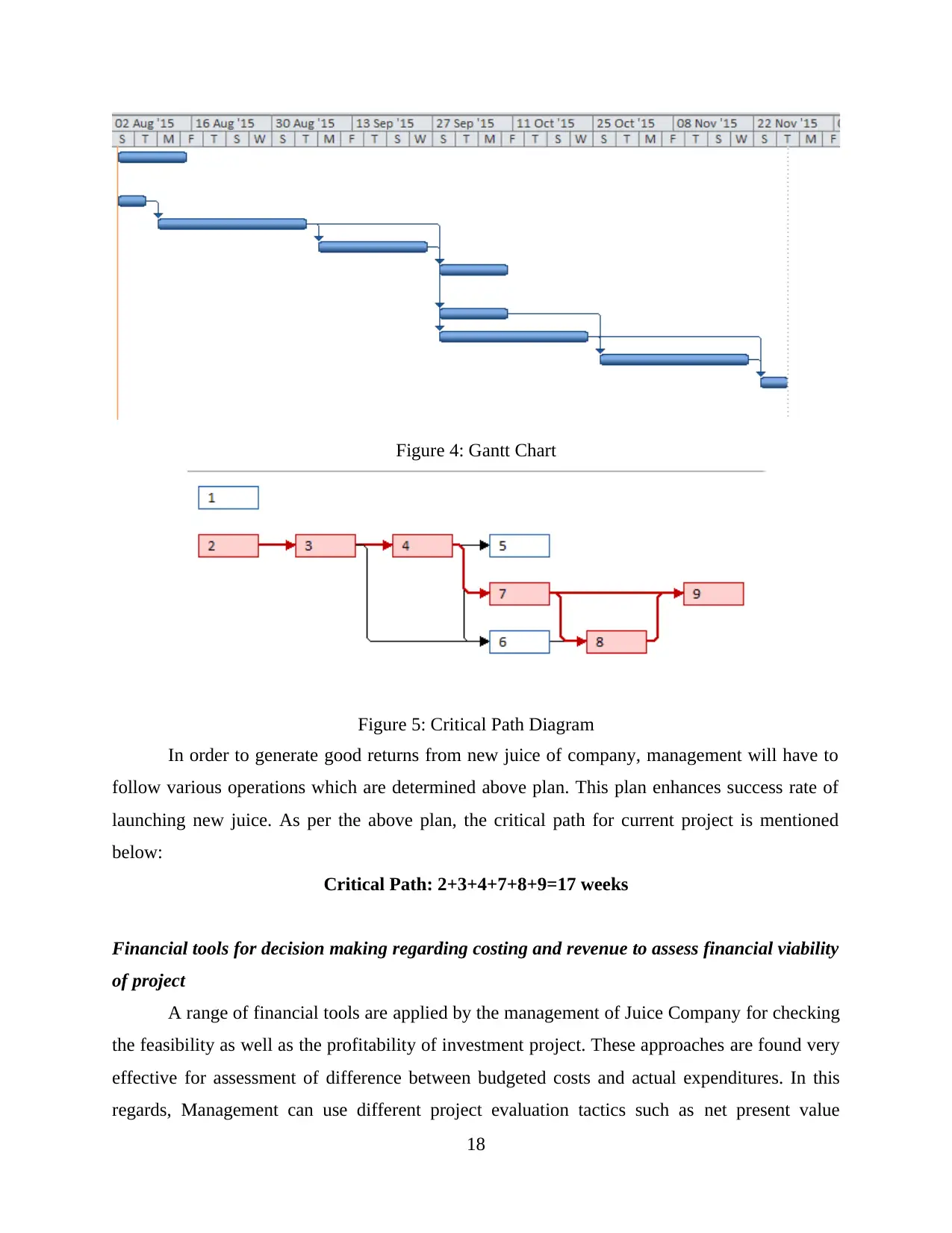
Figure 4: Gantt Chart
Figure 5: Critical Path Diagram
In order to generate good returns from new juice of company, management will have to
follow various operations which are determined above plan. This plan enhances success rate of
launching new juice. As per the above plan, the critical path for current project is mentioned
below:
Critical Path: 2+3+4+7+8+9=17 weeks
Financial tools for decision making regarding costing and revenue to assess financial viability
of project
A range of financial tools are applied by the management of Juice Company for checking
the feasibility as well as the profitability of investment project. These approaches are found very
effective for assessment of difference between budgeted costs and actual expenditures. In this
regards, Management can use different project evaluation tactics such as net present value
18
Figure 5: Critical Path Diagram
In order to generate good returns from new juice of company, management will have to
follow various operations which are determined above plan. This plan enhances success rate of
launching new juice. As per the above plan, the critical path for current project is mentioned
below:
Critical Path: 2+3+4+7+8+9=17 weeks
Financial tools for decision making regarding costing and revenue to assess financial viability
of project
A range of financial tools are applied by the management of Juice Company for checking
the feasibility as well as the profitability of investment project. These approaches are found very
effective for assessment of difference between budgeted costs and actual expenditures. In this
regards, Management can use different project evaluation tactics such as net present value
18
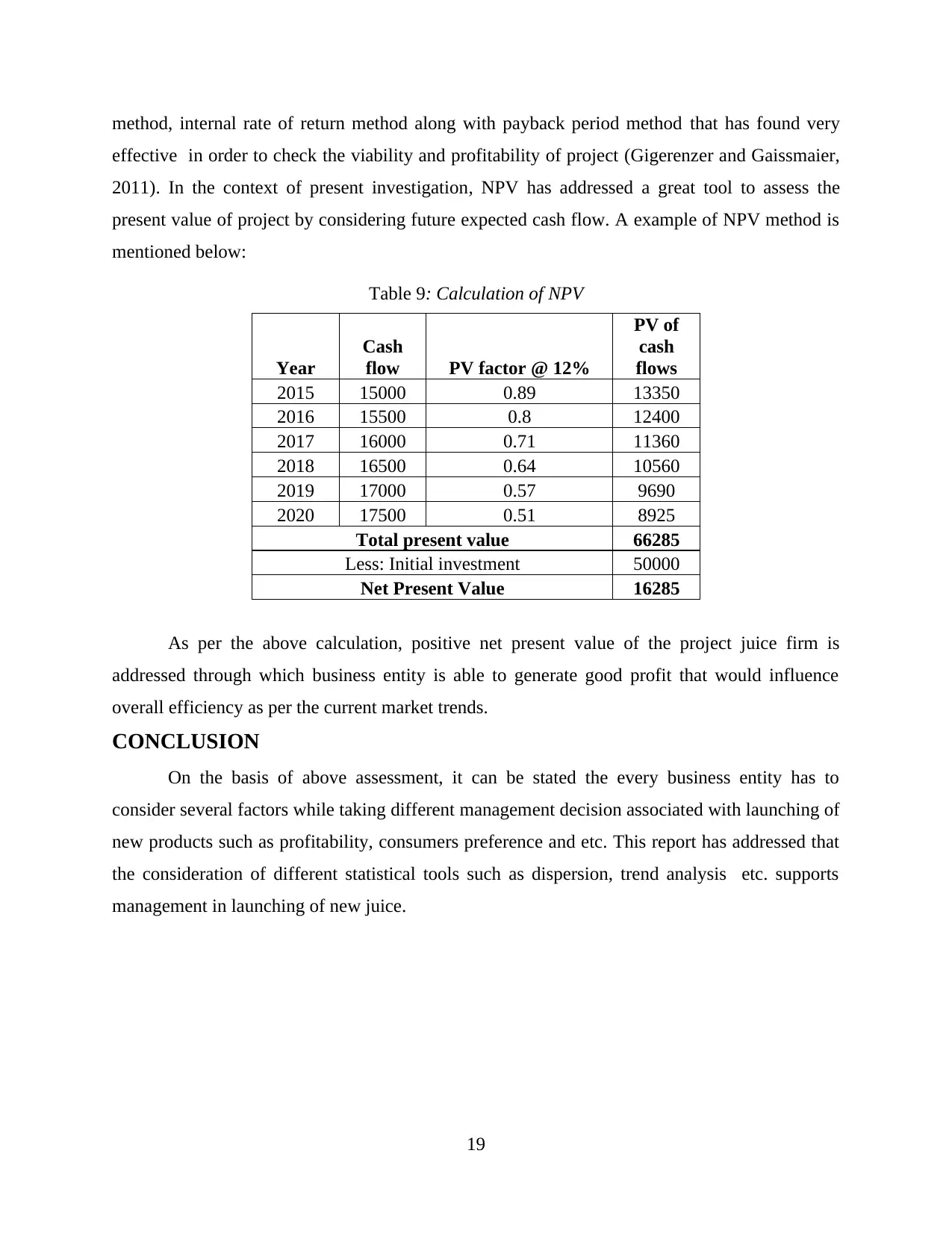
method, internal rate of return method along with payback period method that has found very
effective in order to check the viability and profitability of project (Gigerenzer and Gaissmaier,
2011). In the context of present investigation, NPV has addressed a great tool to assess the
present value of project by considering future expected cash flow. A example of NPV method is
mentioned below:
Table 9: Calculation of NPV
Year
Cash
flow PV factor @ 12%
PV of
cash
flows
2015 15000 0.89 13350
2016 15500 0.8 12400
2017 16000 0.71 11360
2018 16500 0.64 10560
2019 17000 0.57 9690
2020 17500 0.51 8925
Total present value 66285
Less: Initial investment 50000
Net Present Value 16285
As per the above calculation, positive net present value of the project juice firm is
addressed through which business entity is able to generate good profit that would influence
overall efficiency as per the current market trends.
CONCLUSION
On the basis of above assessment, it can be stated the every business entity has to
consider several factors while taking different management decision associated with launching of
new products such as profitability, consumers preference and etc. This report has addressed that
the consideration of different statistical tools such as dispersion, trend analysis etc. supports
management in launching of new juice.
19
effective in order to check the viability and profitability of project (Gigerenzer and Gaissmaier,
2011). In the context of present investigation, NPV has addressed a great tool to assess the
present value of project by considering future expected cash flow. A example of NPV method is
mentioned below:
Table 9: Calculation of NPV
Year
Cash
flow PV factor @ 12%
PV of
cash
flows
2015 15000 0.89 13350
2016 15500 0.8 12400
2017 16000 0.71 11360
2018 16500 0.64 10560
2019 17000 0.57 9690
2020 17500 0.51 8925
Total present value 66285
Less: Initial investment 50000
Net Present Value 16285
As per the above calculation, positive net present value of the project juice firm is
addressed through which business entity is able to generate good profit that would influence
overall efficiency as per the current market trends.
CONCLUSION
On the basis of above assessment, it can be stated the every business entity has to
consider several factors while taking different management decision associated with launching of
new products such as profitability, consumers preference and etc. This report has addressed that
the consideration of different statistical tools such as dispersion, trend analysis etc. supports
management in launching of new juice.
19
Paraphrase This Document
Need a fresh take? Get an instant paraphrase of this document with our AI Paraphraser
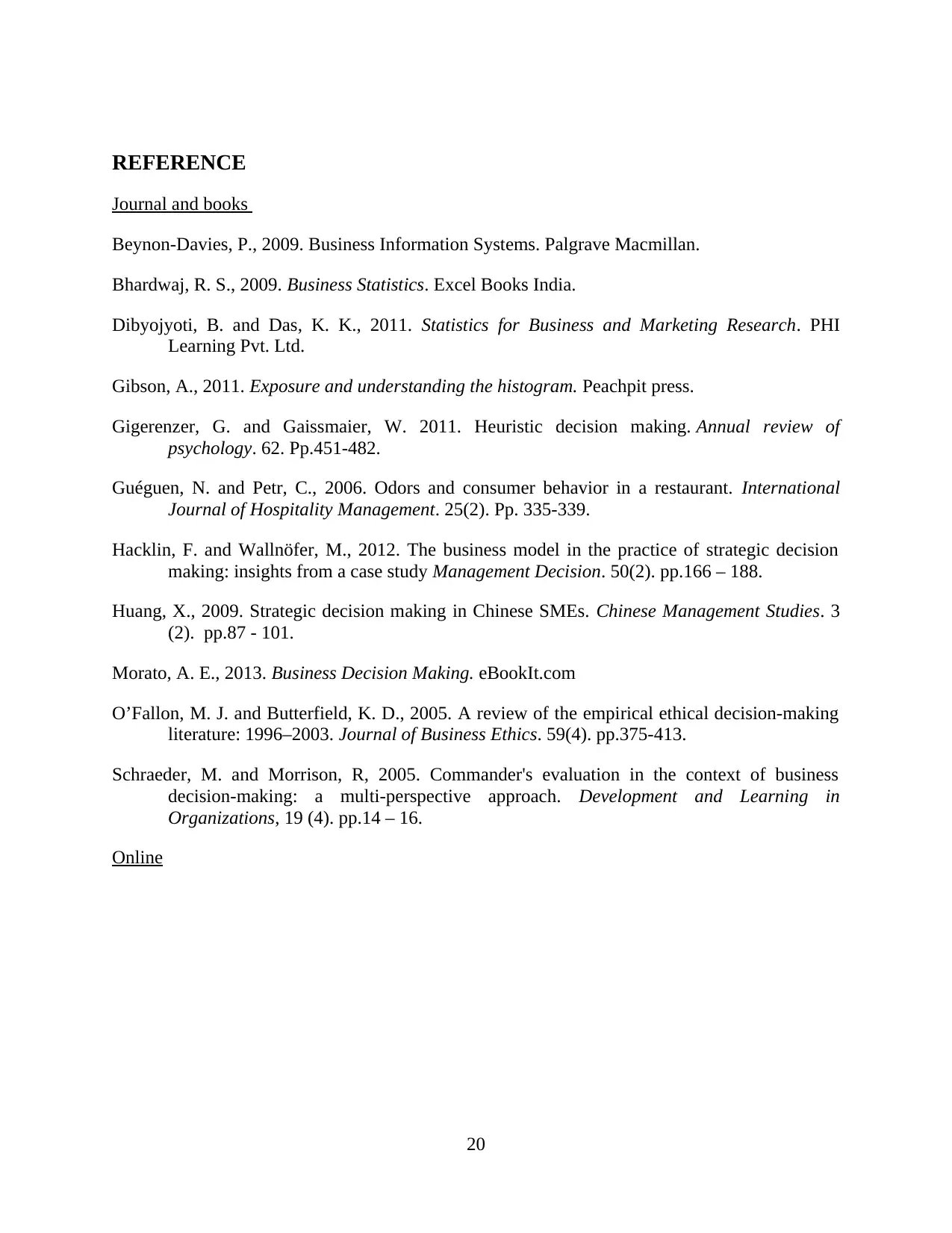
REFERENCE
Journal and books
Beynon-Davies, P., 2009. Business Information Systems. Palgrave Macmillan.
Bhardwaj, R. S., 2009. Business Statistics. Excel Books India.
Dibyojyoti, B. and Das, K. K., 2011. Statistics for Business and Marketing Research. PHI
Learning Pvt. Ltd.
Gibson, A., 2011. Exposure and understanding the histogram. Peachpit press.
Gigerenzer, G. and Gaissmaier, W. 2011. Heuristic decision making. Annual review of
psychology. 62. Pp.451-482.
Guéguen, N. and Petr, C., 2006. Odors and consumer behavior in a restaurant. International
Journal of Hospitality Management. 25(2). Pp. 335-339.
Hacklin, F. and Wallnöfer, M., 2012. The business model in the practice of strategic decision
making: insights from a case study Management Decision. 50(2). pp.166 – 188.
Huang, X., 2009. Strategic decision making in Chinese SMEs. Chinese Management Studies. 3
(2). pp.87 - 101.
Morato, A. E., 2013. Business Decision Making. eBookIt.com
O’Fallon, M. J. and Butterfield, K. D., 2005. A review of the empirical ethical decision-making
literature: 1996–2003. Journal of Business Ethics. 59(4). pp.375-413.
Schraeder, M. and Morrison, R, 2005. Commander's evaluation in the context of business
decision-making: a multi-perspective approach. Development and Learning in
Organizations, 19 (4). pp.14 – 16.
Online
20
Journal and books
Beynon-Davies, P., 2009. Business Information Systems. Palgrave Macmillan.
Bhardwaj, R. S., 2009. Business Statistics. Excel Books India.
Dibyojyoti, B. and Das, K. K., 2011. Statistics for Business and Marketing Research. PHI
Learning Pvt. Ltd.
Gibson, A., 2011. Exposure and understanding the histogram. Peachpit press.
Gigerenzer, G. and Gaissmaier, W. 2011. Heuristic decision making. Annual review of
psychology. 62. Pp.451-482.
Guéguen, N. and Petr, C., 2006. Odors and consumer behavior in a restaurant. International
Journal of Hospitality Management. 25(2). Pp. 335-339.
Hacklin, F. and Wallnöfer, M., 2012. The business model in the practice of strategic decision
making: insights from a case study Management Decision. 50(2). pp.166 – 188.
Huang, X., 2009. Strategic decision making in Chinese SMEs. Chinese Management Studies. 3
(2). pp.87 - 101.
Morato, A. E., 2013. Business Decision Making. eBookIt.com
O’Fallon, M. J. and Butterfield, K. D., 2005. A review of the empirical ethical decision-making
literature: 1996–2003. Journal of Business Ethics. 59(4). pp.375-413.
Schraeder, M. and Morrison, R, 2005. Commander's evaluation in the context of business
decision-making: a multi-perspective approach. Development and Learning in
Organizations, 19 (4). pp.14 – 16.
Online
20

Leitz, P., 2009. Research into questionnaire design. [Pdf]. Available through:
<https://www.cse.edu/dotAsset/134306.pdf>. [Accessed on 21st November 2015].
Measures of Dispersion. 2013. [Online] Available through:< http://www.mathsrevision.net/advanced-
level-maths-revision/statistics/measures-dispersion>. [Accessed on 21st November 2015].
<https://www.cse.edu/dotAsset/134306.pdf>. [Accessed on 21st November 2015].
Measures of Dispersion. 2013. [Online] Available through:< http://www.mathsrevision.net/advanced-
level-maths-revision/statistics/measures-dispersion>. [Accessed on 21st November 2015].
1 out of 21
Related Documents
Your All-in-One AI-Powered Toolkit for Academic Success.
+13062052269
info@desklib.com
Available 24*7 on WhatsApp / Email
![[object Object]](/_next/static/media/star-bottom.7253800d.svg)
Unlock your academic potential
© 2024 | Zucol Services PVT LTD | All rights reserved.





